Persuasive Advertising: What It Is & How to Do It [+Examples]
Published: September 28, 2021
What are some advertisements that live rent-free in your mind? As a millennial, ads that will always have a place in my heart include Britney Spears' iconic run as a Pepsi spokesperson, the enduring"got milk?" campaign (which is ironic considering myself and many others now prefer non-dairy alternatives), and the classic iPod silhouettes.

These ads were not only compelling, but they were also incredibly influential. As marketers, we know that if we want to persuade an audience , we need to evoke an emotional response from them. But how do you actually do that?

Before we discuss how to refine your persuasive advertising strategy, let's review what it is.

What is persuasive advertising?
Persuasive advertising leverages the desires and interests of consumers to convince them to purchase a product or service. This form of advertising often focuses on the benefits the product or service can offer the end-user.
Below, we’ll examine key persuasive advertising techniques you can use in your advertisements, examples you can reference if you ever need some inspiration and informative advertisement examples that are surprisingly just as compelling as the persuasive advertising examples.
Persuasive Advertising Techniques
- The Carrot and The Stick
- The Scarcity Principle
- One Message Per Advertisement
- Write in the Second Person
- Give Your Audience a Sense of Control
- Use a Call-to-Value Instead of a Call-to-Action
1. The Carrot and The Stick
Humans are hardwired to move towards pleasure, like a horse towards a carrot, and away from pain, like a donkey avoids a stick. When people read or watch your advertisements, "carrots", or promises of gain, can fill your prospects with hope and compel them to pursue that potential feeling of pleasure. "Sticks", possibilities of loss, evoke fear in your prospects, which will compel them to flee from that potential feeling of pain.
Both tactics can pull your prospects into a narrative and evoke emotions that inspire your desired action. Carrots, like a product’s benefit, entice people to take the desired action. Sticks, on the other hand, like anti-smoking campaigns, evoke fear in people to stop doing a certain action and start doing the alternative. To better understand how to craft advertisements that feature a carrot or stick, check out these insurance copywriting examples below.
Carrot: "15 minutes could save you 15% on car insurance." — Geico
Stick: "Get All-State. You can save money and be better protected from Mayhem like me." — All-State
As you can see, Geico's ad uses a small-time investment that could potentially produce big gains as a lure to get you to buy their product. Conversely, All-State’s ad uses the character"Mayhem" to evoke fear into people to stop using their"inferior" insurance and start using All-State’s.
2. The Scarcity Principle
People value objects and experiences that are rare — having something that most people want but can’t have, boosts our sense of self-worth and power . If you use words and phrases that imply scarcity and evoke a sense of urgency, like"Exclusive offer" or"Limited availability", you can skyrocket your product’s perceived scarcity and consumer demand.
3. One Message Per Advertisement
To immediately hook people and persuade them to read or watch the rest of your advertisement, try sticking to only one message. Spotlighting your product or offer’s main benefit or feature will make it easy for your customers to understand its value and increase the likelihood of their conversion because you’re only conveying one message to your audience: your product’s main feature will benefit your customer’s life somehow, someway.
4. Write in the Second Person
Since your prospects primarily care about how you can help them, and pronouns like "you" and "your" can engage them on a personal level and help them insert themselves in the narrative you’re creating, writing advertisements in the second person can instantly grip their attention and help them imagine a future with your product or service bettering their lives.
5. Give Your Audience a Sense of Control
According to a research study conducted by three psychology professors at Rutgers University, the need for control is a biological and psychological necessity. People have to feel like they have control over their lives.
If you want to give your audience a sense of control, you need to give them the ability to choose. In other words, after reading or watching your advertisement, they must feel like they can choose between the option you suggest or another path. If they feel like you’re trying to force them to buy your product, they’ll get annoyed and disengage from your message.
To give your audience the ability to choose, and in turn, a sense of control, use phrases like "Feel free" or "No pressure" in your advertisements, like this example from Hotwire.com below.
6. Use a Call-to-Value Instead of a Call-to-Action
Call-to-actions are crucial for getting prospects to take the next step, but a "Download Now" or "Call Now" CTA isn’t always going to convince the more skeptical prospects to take your desired action. You need to make sure your ad’s last line of copy or quip is the best of them all.
So instead of writing an uninspiring, final line of copy like "Download Now", write one that clearly communicates your offer’s value and gives a glimpse into your prospects’ potential life if they take your desired action, like this call-to-value prompting readers to download a blogging eBook: "Click today and be a blogger tomorrow."
Persuasive Advertising Examples
Ready to see persuasive advertising in action? Check out these examples.
Showing — not telling — your audience about your product’s benefits is one of the best ways to capture attention and get an emotional response. Obviously, Nikol’s paper towels can’t actually turn grapes into raisins, but this ad highlights the product's absorbent powers in such a clear and clever way, they didn’t need to write a single line of copy.

-9.png?width=450&name=pasted%20image%200%20(1)-9.png)
-6.png?width=450&name=pasted%20image%200%20(2)-6.png)
"More Than OK" poked fun at how Pepsi usually takes a back seat to Coke, especially at restaurants. And by featuring a star-studded cast that included Steve Carell, Lil Jon, and Cardi-B (who hilariously and fervently backed up Pepsi’s OKness) their boldness to call people out for undermining Pepsi’s quality got a lot of laughs and persuaded a massive audience to reconsider their own perception of the soft drink.
7. Match.com
The year 2020 was challenging for countless reasons. Online dating company Match.com channeled the collective feeling towards the year with an ad depicting Satan meeting his perfect match – 2020.
Informative Advertising
Informative advertising is a form of persuasive advertising that focuses more on the facts. The main goal of informative advertising is to educate the audience on why they need your product instead of appealing to their desires.
It highlights how your product’s features and benefits solve your customers’ problems and can even compare your product to your competitors' products. Although this type of advertising relies on facts and figures to trigger the desired action, the ad’s message is usually framed in a compelling way.
To better understand the difference between informative and persuasive advertising, check out these examples.
Informative Advertising Examples
- Miller Lite
- Siskiyou Eye Center
- Burger King
1. Miller Lite
After Bud Light took some jabs at Miller Lite for using corn syrup in their beer during their Super Bowl 53 ads , Miller Lite decided to throw a few punches back. A day later on Twitter, they revealed that their beer actually has fewer calories and carbs than Bud Light, which helped them persuade people that drinking Bud Light and Miller Lite actually have similar health benefits.

2. Siskiyou Eye Center
There’s an old folk tale that carrots can improve your eyesight, but science has actually debunked this myth . That’s why this Siskiyou Eye Center ad is such a creative informative advertisement.
While it pokes fun at this common fable, it’s still relying on the facts of carrots not being able to improve your vision and the Eye Center’s ability to provide quality treatment for your eyes to persuade people to do business with them.
-2.png?width=450&name=pasted%20image%200%20(6)-2.png)
Popular meditation app Calm experienced an increase in downloads by sponsoring CNN's coverage of the 2020 US Presidential Campaign. Through clever product placement in front of an audience that was experiencing stress, the app was positioned as helpful a resource ready to educate on mindfulness during a turbulent time.

In addition to creating popular body and skincare products, Dove has set out to educate its audience on the importance of body confidence, and the harmful impact fabricated social media imagery can have on the self-esteem of young people.
In the reverse selfie campaign, Dove depicts how social media users may be inclined to change their appearance for public approval. Other materials provided by Dove also share facts and statistics related to social media usage and body image.
Last year, Google released a Black History Month ad called "The Most Searched" that was equally informative and inspiring. Showing clips of famous Black figures, each clip read "most searched" to indicate each person shown and event shown was a history-maker.
Persuasive advertising vs. informative advertising: which one is better?
Persuasive advertising and informative advertising definitely focus on different aspects of persuasion, but they still aim to achieve the same goal: convincing your audience to take the desired action. So whether you pursue one advertising strategy or another, remember that if you can trigger an emotional response, regardless of the stimuli, your ad will be a success.
Editor's note: This post was originally published in October 2019 and has been updated for comprehensiveness.

Don't forget to share this post!
Related articles.

The Worst Super Bowl Ads — Avoid These Blunders

Google's Head of Technology Platforms On How First-Party Data & AI Will Transform The Ad Industry — For The Better

Online Advertising: All You Need to Know in 2023

The 18 Most Creative Ad Campaigns in History
![persuasive text advertisement How to Make an Ad: A 15-Step Guide [+Expert Tips]](https://blog.hubspot.com/hubfs/how%20to%20make%20an%20ad.png)
How to Make an Ad: A 15-Step Guide [+Expert Tips]

32 Free Advertising Tips for Your Small, Large, or Local Business
![persuasive text advertisement How Consumers Responded to Black Friday in 2022 [+ Holiday Marketing Tips]](https://blog.hubspot.com/hubfs/black-friday-ads_0.webp)
How Consumers Responded to Black Friday in 2022 [+ Holiday Marketing Tips]
![persuasive text advertisement What is Comparative Advertising? [+ Examples]](https://blog.hubspot.com/hubfs/Untitled%20design-Aug-17-2022-02-39-51-39-PM.png)
What is Comparative Advertising? [+ Examples]
![persuasive text advertisement How to Prepare an Advertising Plan [Free Template]](https://blog.hubspot.com/hubfs/advertising%20plan%20example.jpg)
How to Prepare an Advertising Plan [Free Template]

How to Prevent Click Fraud
Plan and launch an effective advertising campaign with this guide and set of templates.
Marketing software that helps you drive revenue, save time and resources, and measure and optimize your investments — all on one easy-to-use platform
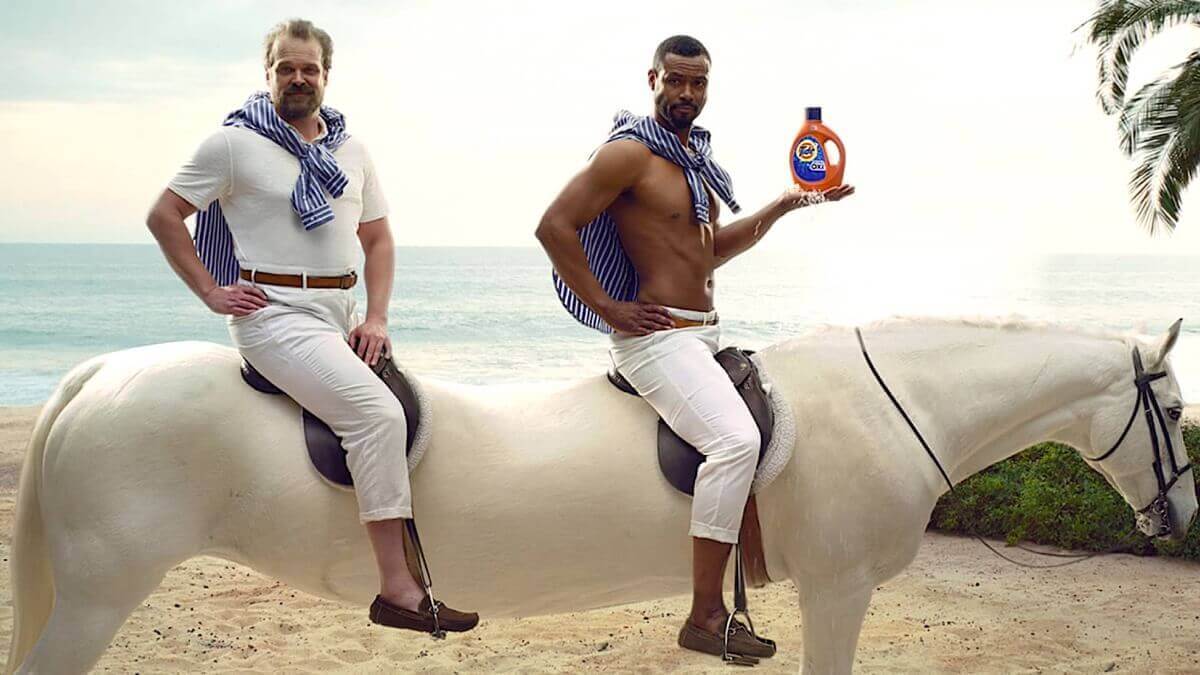
- Development
Ethos, Pathos & Logos: Definition and Examples of Persuasive Advertising Techniques (2023)
- What is Pathos
- What is Logos
- What is Telos
- What is Kairos
- What is Ethos
- Ethos, Pathos & Logos
- What is an EPK
- What is a Creative Director
- What is Branded Content
- What is a Creative Brief
- How to Pitch a TV Show Like a Pro
- How Does Rotten Tomatoes Work?
- How to Make a Movie Poster
- The Filmmaker’s Guide to The Clio Advertising Awards
- A Complete Guide To The Funniest Commercials
- How to Make a Commercial
- How to Develop Your Brand
- Complete Guide to Advertising on Instagram
- How Does Instagram Promotion Work and Is It Worth It?
- How Can You Kickstart Your Social Media Advertising?
- Small Business Advertising Ideas from LeBron James Commercials
- How To Create a Successful Branded Content Campaign
- How and Why To Make Facebook Video Ads That Work
- How to Make a Commercial People Will Actually Share
- Video Branding Strategies to Get More Followers Right Now
- Social Media and Digital Communications for Successful Short Films
- Digital Advertising Trends
- Most Inspiring Ads
- Best Movie Taglines
- Best Marketing and Advertising Campaigns
- Best Creative Brief Template
- Best Explainer Video Trends for Your Brand
E thos, pathos and logos are techniques of persuasion that form the rhetorical triangle. A compelling argument, sales pitch, speech, or commercial ideally uses elements of all three strategies. We’ll show you how to employ each of the techniques and present some awesome examples along the way.
Ethos, Pathos and Logos: How to Create Persuasive Ads
Ethos, Pathos, Logos, Definition
Persuasion in advertising.
What are persuasive advertising techniques? They're how you convince a buyer of your product through visuals.
You can thank Aristotle for inventing persuasive advertising techniques . More than 2,000 years ago, he categorized how rhetoric is used in arguments into three groups: ethos, pathos and logos.
This is also known as the the rhetorical triangle .
And we still depend on it today.
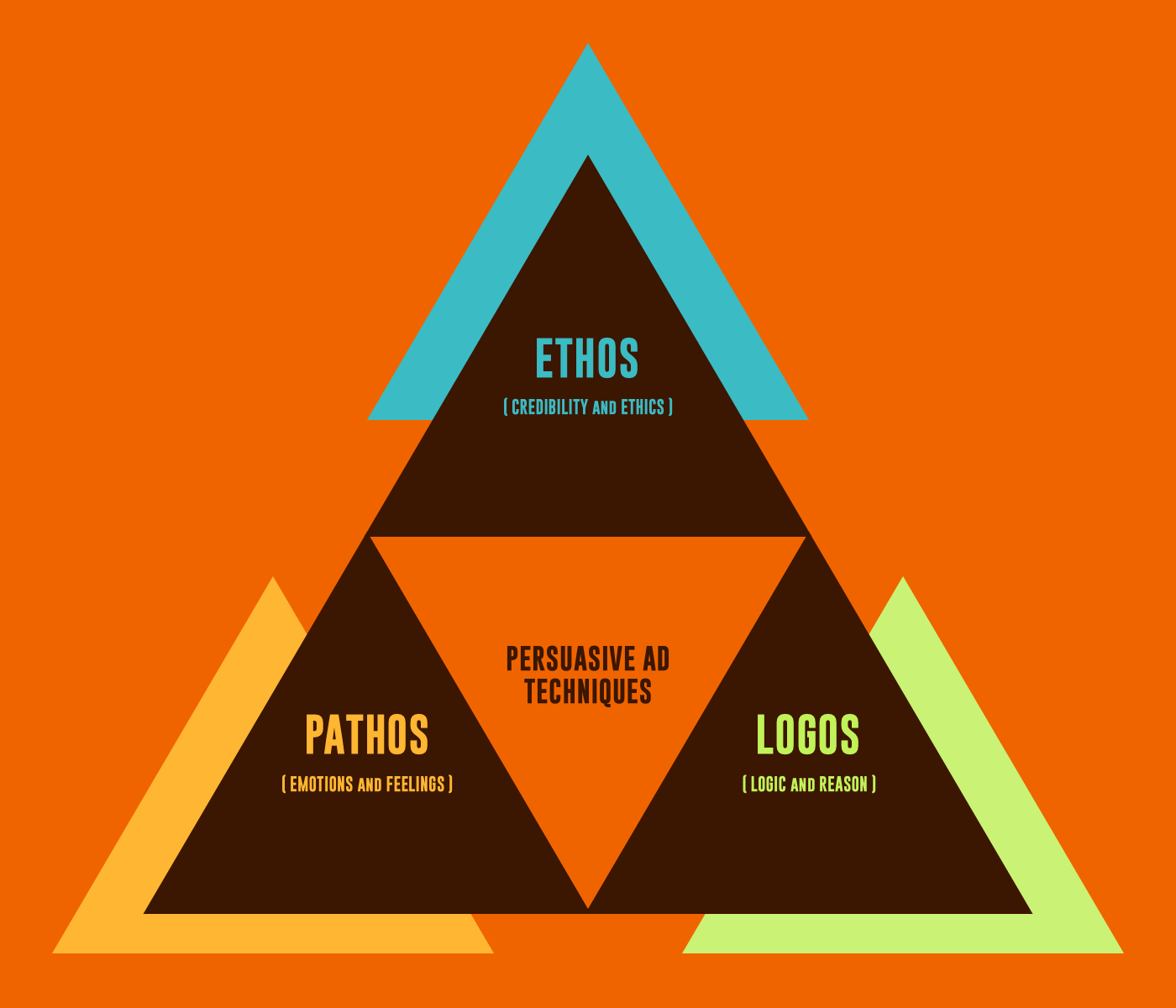
Ethos, pathos and logos are the three categories of persuasive advertising techniques.
Each category invokes a different appeal between speaker and audience.
Ethos calls upon the ethics, or what we'd call the values, of the speaker. Pathos elicits emotions in the audience. Finally, logos puts logic into play by using evidence and facts.
Good persuasive advertising technique is when you balance all three.
But using ethos, pathos and logos in commercials sometimes means featuring one advertising technique prominently.
ETHOS DEFINITION
What is ethos.
Ethos is the persuasive technique that appeals to an audience by highlighting credibility. Ethos advertisement techniques invoke the superior “character” of a speaker, presenter, writer, or brand.
Ethos examples aim to convince the audience that the advertiser is reliable and ethical. It’s easier to make a decision when someone you respect signs off on it, right?
This is broadly the function of ethos in commercials.
When an esteemed public figure endorses a product, it validates it to the end consumer.
An ethos advertisement plays off the consumer’s respect for a given spokesperson.
Through that respect, the spokesperson appears convincing, authoritative and trustworthy enough to listen to. Of the types of persuasive techniques in advertising, ethos is best used to unlock trust.
USE OF ETHOS IN ADVERTISING
How is ethos used in advertising.
So what does ethos mean?
It’s all about credibility. Famous people enjoy a high status in our society. So they’re the ones selling products to us -- whether or not they have product-specific expertise.
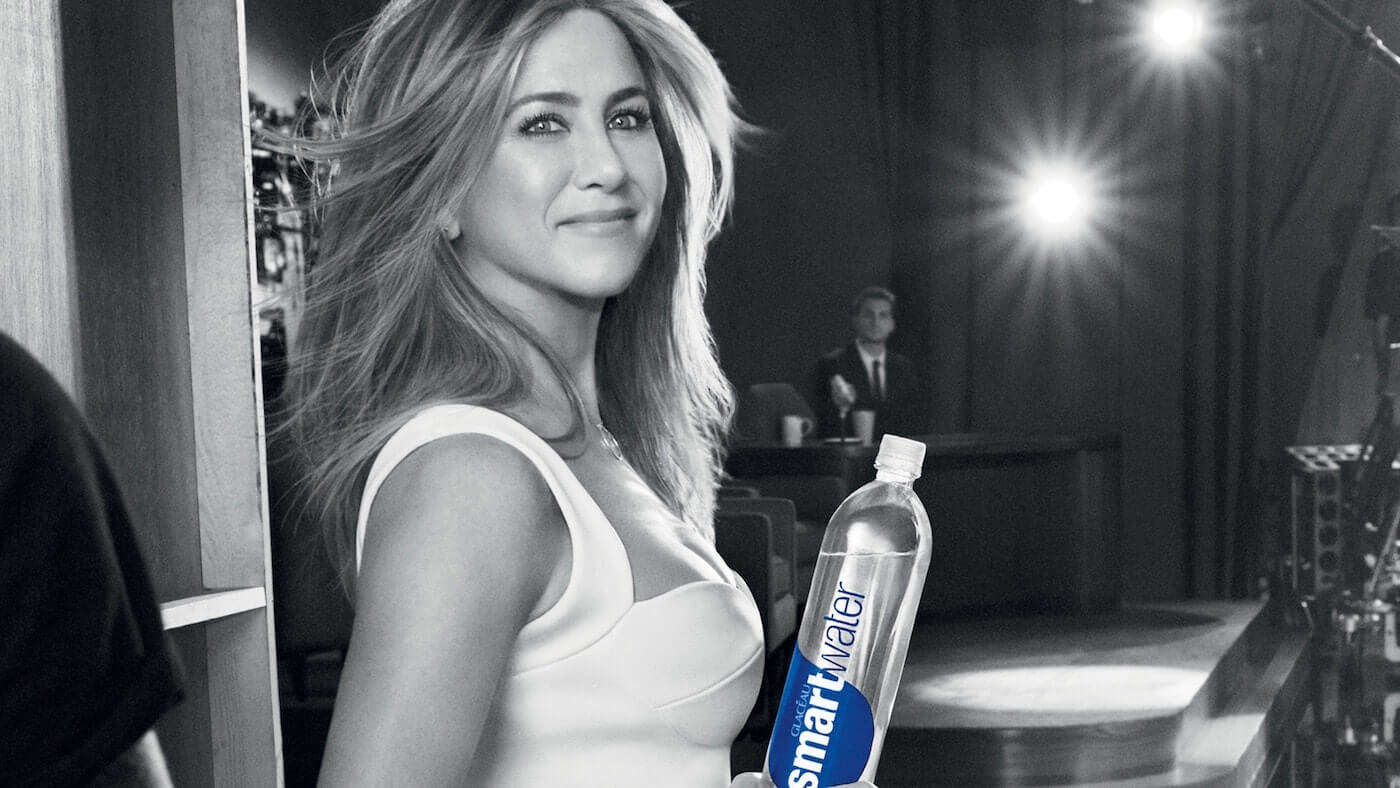
Example of ethos in advertising: Jennifer Aniston in a campaign for Glaceau Smart Water
For example, a recent Infiniti commercial featured Steph Curry. Even though he’s not known for his taste in vehicles, his stature validates the product.
This is ethos in commercials at work.
Example of ethos in commercials: Steph Curry in a recent spot for Infiniti.
Ethos rhetoric is also invoked to tie a brand to fundamental rights.
Brands build trust with their audience when they stand with an important cause. Anheuser-Busch illustrated this in their recent “Born the Hard Way” spot.
Ethos examples: This ethos advertisement by Anheuser-Busch underscores the value of multiculturalism.
This spot focuses on the origin story of Anheuser-Busch’s founders.
It shows Busch’s turbulent immigration from Germany to St. Louis, and speaks to the importance of immigration and multiculturalism.
This is how ethos rhetoric is used in advertising.
Of the many types of persuasive advertising techniques in advertising, ethos is best for playing up the strength of a brand or spokesperson’s character.
ETHOS EXAMPLE IN COMMERCIALS
Ethos advert case study.
If you want a really strong example of Ethos that also has a pretty funny meta quality to it, check out the shot list for this Heineken spot. See how many times they use foreground elements and OTS shots in this spot:
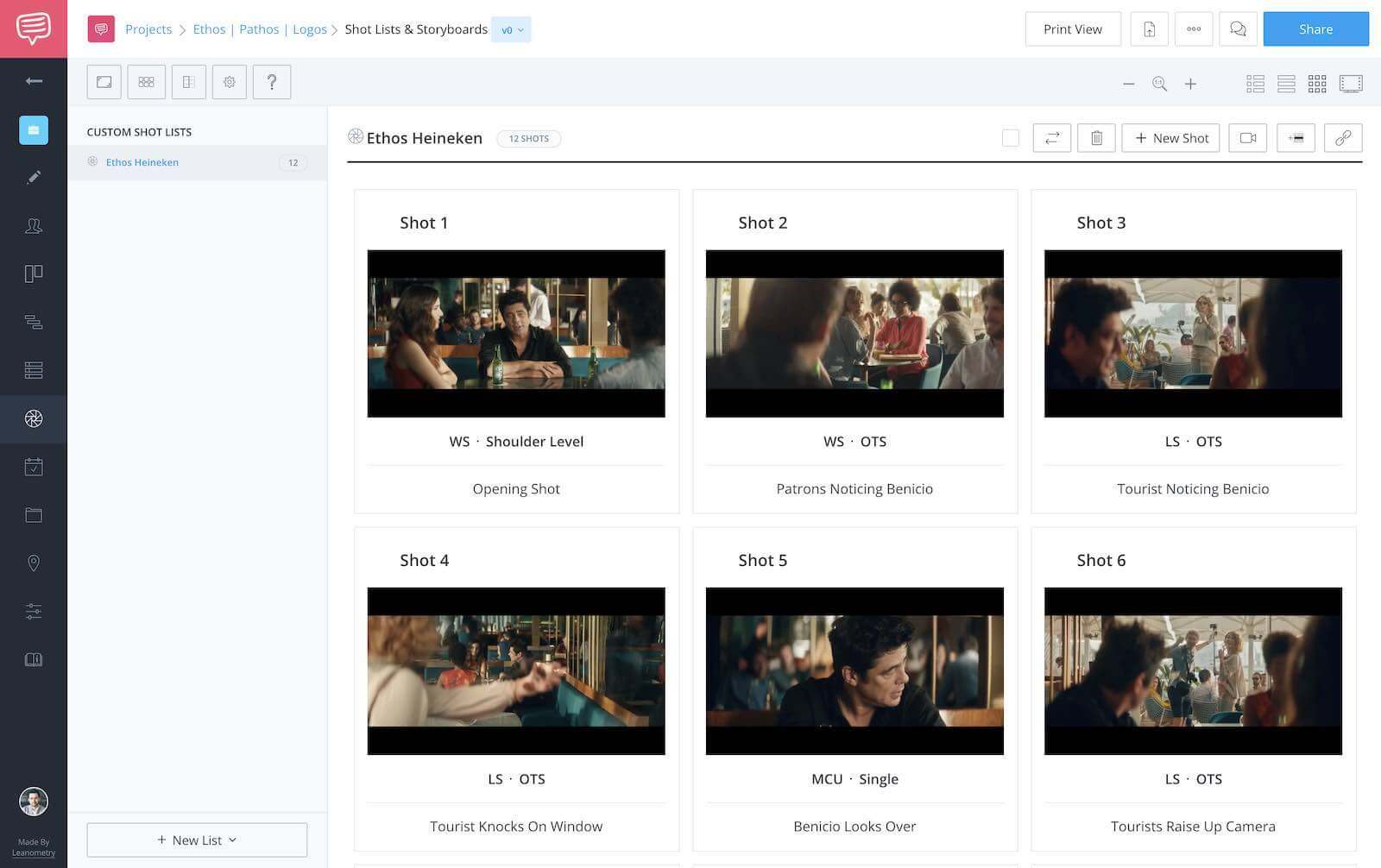
Ethos Examples • Shot Listed in StudioBinder
This Heineken commercial shows famous actor Benicio Del Toro at the bar enjoying a Heineken. Benicio chats about how both he, and Heineken, are world famous and instantly recognizable.
Then, a pair of goofy tourists spot him in the bar, and they call out for him to pose for a photo, but... they actually think he's Antonio Banderas.
Ethos Example in Heineken Commercial
This commercial not only uses ethos as a way to tie the celebrity of Benicio to the celebrity of Heineken, but it uses humor and the bold faced usage of ethos to make fun of the brand, people, and fame.
THE "PLAIN FOLKS" PERSUASIVE ADVERTISING TECHNIQUE
How is "plain folks" used in ads.
Ethos rhetoric often employs imagery of everyday, ordinary people.
Known as the Plain Folks persuasive advertising technique, in this approach a spokesperson or brand appears as an Average Joe to feel common and sensible. In doing so, they appear concerned and cut from the same cloth as you.
This approach is very common in political ads. Consider the “Family Strong” ad from Hillary Clinton’s 2016 presidential campaign.
Ethos Examples: Hillary Clinton underscores the “Plain Folks” definition in her campaign videos.
Despite her status and wealth, Clinton draws on imagery of her family and upbringing to make her feel more relatable. In this way, “Plain” folks is propaganda and also a logical fallacy .
But it’s also an effective and persuasive advertising technique.
Of the types of persuasive techniques in advertising, Plain Folks aligns your brand with the values of the everyday consumer.
Related Posts
- Learn: Creative Digital Advertising Trends →
- 5 Steps to Make a Persuasive Commercial →
- Learn: How to Make a Storyboard in 9 Steps →
Pathos DEFINITION
What is pathos.
Pathos is persuasive technique that try to convince an audience through emotions. Pathos advertisement techniques appeal to the senses, memory, nostalgia, or shared experience. Pathos examples pull at the heartstrings and make the audience feel.
A quick way to appeal to a viewer’s emotions? A cute animal. A devastated family. A love story. Overcoming great odds. An inspirational song and imagery. A good zinger.
Learn More Logos Ethos and Pathos
Comparing other techniques.
There are many types of rhetorical strategies. To get a full picure on how they work together, or when to use which rhetorical strategies, explore the full guide below.
EVERYTHING ABOUT Rhetorical appeals
Basics & terminology, appeal to credibility , appeal to emotion, appeal to logic, appeal to purpose, appeal to timeliness.
Each of these rhetorical strategies can be effective in its own way. When combined, their potential effects grow exponentially. To fully understand the power of persusaion, these are the tools you need.
Emotions create responses and, in our increasingly consumer-driven culture, the response is to buy something. Pathos appeals to an audience’s basic emotions like joy, fear, and envy. All are easily triggered in many ways.
So what is pathos?
Well, it's a model enjoying a refreshing Coke. Or a frustrated infomercial character desperate for a better remedy. And "tired" of the "same old blah-blah-blah."
The many different pathos advertisement examples not only evoke your feelings but anticipate your responses too. If you want to explore pathos in advertising, language is the best place to start.
Because the words we hear and read trigger specific feelings . Positive words conjure feelings of love, excitement and wonder.
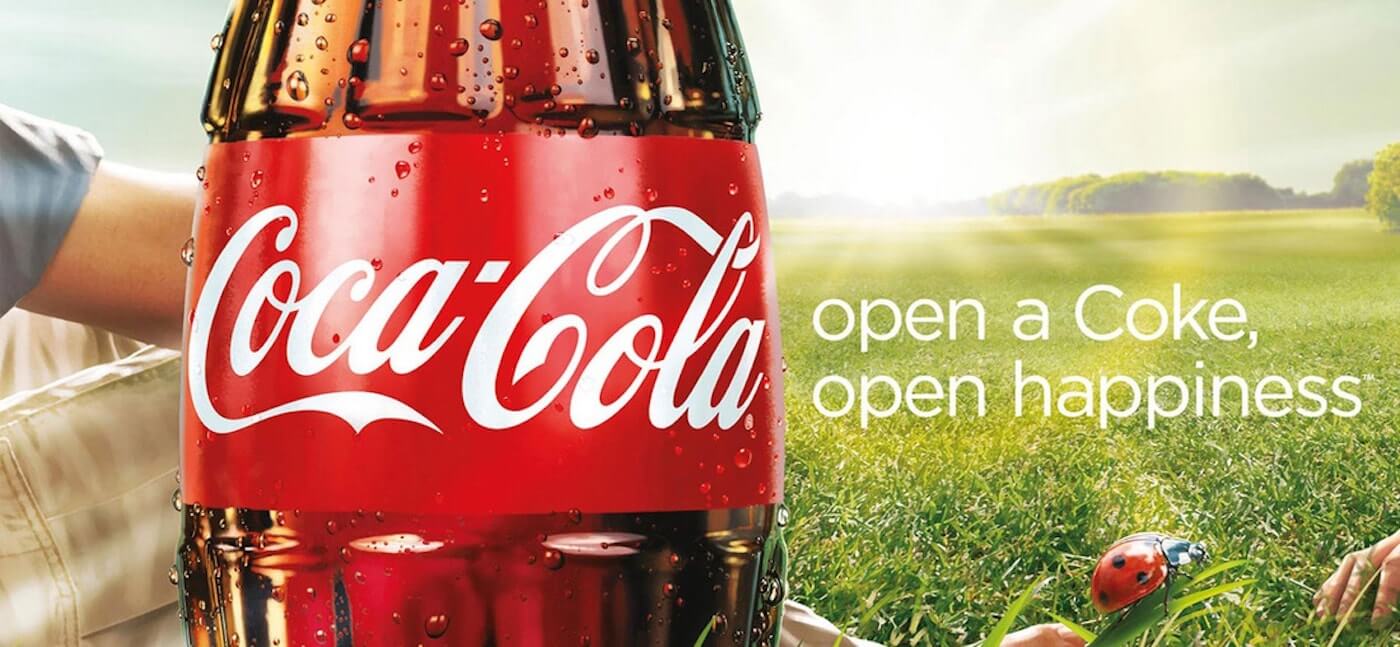
What is pathos? Cutting to the emotional core, really.
Look at how General Mills and Cheerios achieved this in their “Good Goes Round” campaign.
Example of pathos: This Cheerios pathos advertisement injects good vibes with positive words
We see sunshine, smiles and bright colors while we hear the words “good goes around.”
It invites positivity and encourages us to associate Cheerios accordingly.
On the other hand, pathos advertisements can also employ unpleasant emotions like fear and worry just as effectively.
Pathos examples: this somber pathos advertisement says don’t let heart disease happen to you.
This ad by the British Heart Foundation underscores the dangers of heart disease. As the spot unfolds, you start to realize that the narrator suddenly died at her sister’s wedding.
Her tragic story encourages you to not let it happen to you.
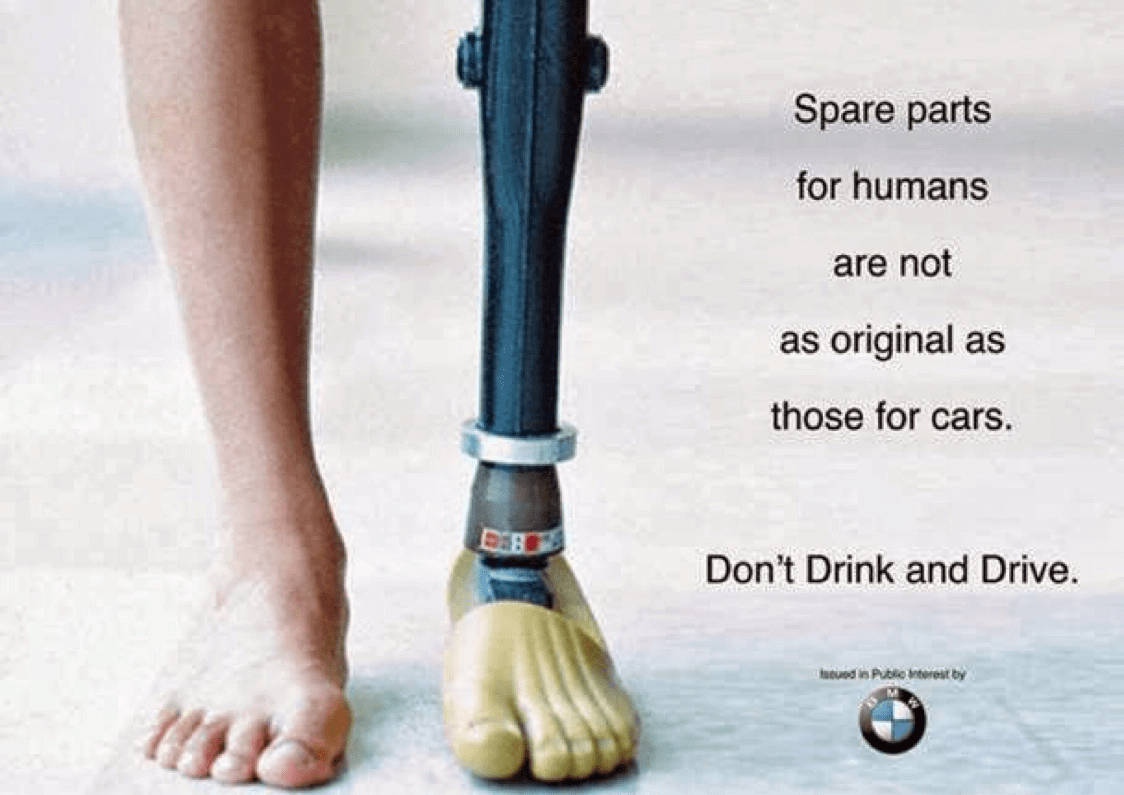
Pathos examples: BMW warns against drinking and driving in this pathos advertisement example.
Pathos example in commercials, pathos advert case study.
If you want a really strong example of pathos is an advertisement, check out this shot list from a particularly emotional Zillow spot. Notice how the shots on the son are often singles and medium close-ups:
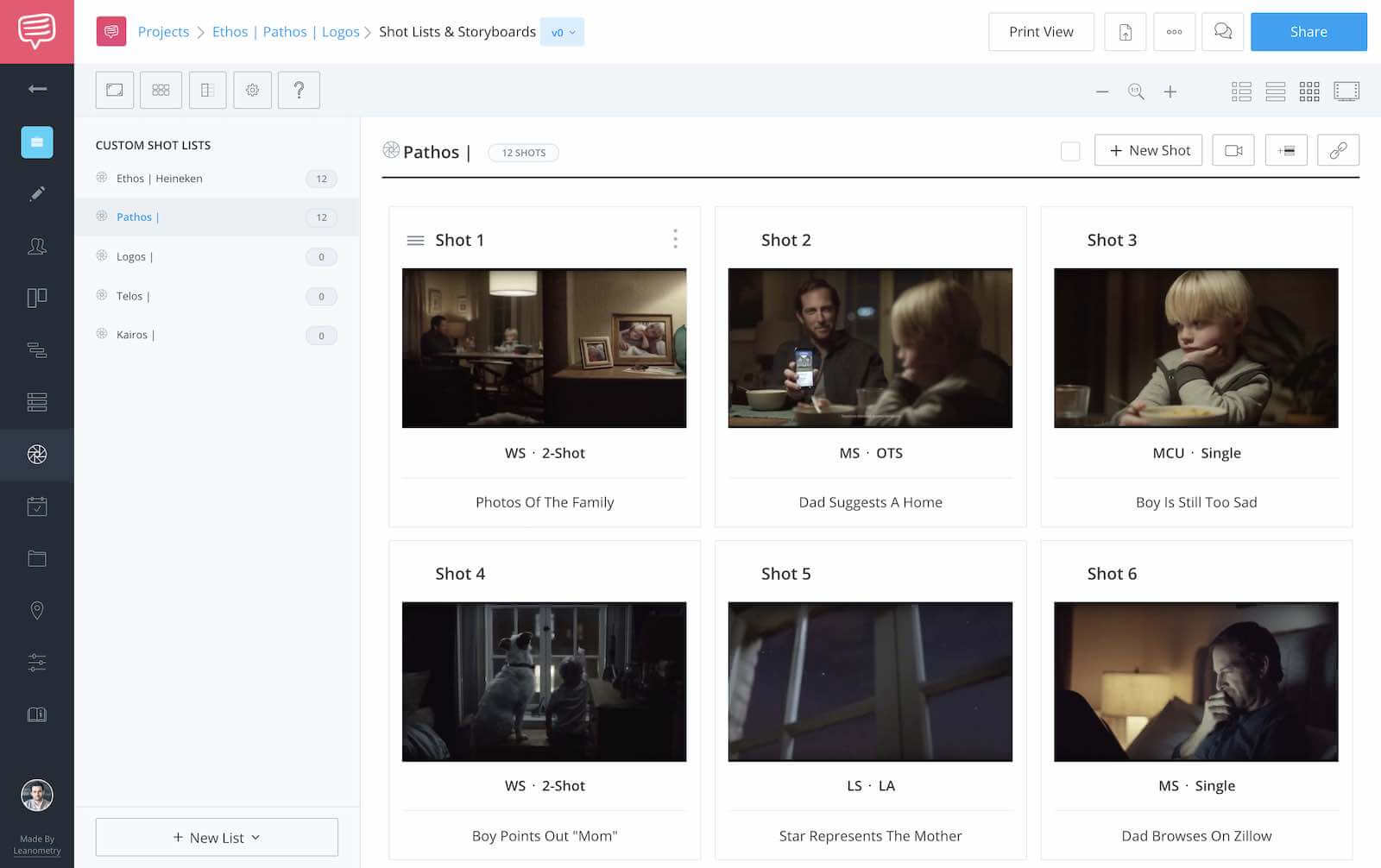
Pathos Examples • Shot Listed in StudioBinder
This Zillow commercial shows a father and son who have just suffered the terrible loss of their wife/mother. The father tries to cheer his son up by finding a new home, one preferably near the boy's grandparents.
The son seems disinterested, but then the father finds his son and the family dog looking up at the stars, one of which is particularly bright. The son decides that the star is his mother, looking down on him.
That gives the father an idea:
Pathos example in Zillow Commercial
The father searches on Zillow, finds a home, and buys it. We then learn that the home is not only close to the grandparents, but it also has a skylight in the son's room, allowing him to see his Mother's star at night.
This commercial uses the emotions of the father, the son, the grandparents, and of course the viewer to suggest that Zillow is the type of website that can balm grief through its functionality.
USE OF PATHOS IN ADVERTISING
The appeal of pathos in advertising.
Sex appeal is of course also hugely successful among the pathos advertising techniques. Open any Cosmopolitan magazine and you’ll find scantily clad models, muscular men and sexual innuendo.
Although the common expression “sex sells” has been debated, sexually provocative ads do leave a lasting impression. Mr. Clean , for example, spiced up their eponymous mascot for comedic effect.
Pathos Examples: This Mr. Clean pathos advertisement gave their mascot a sexy upgrade.
Their brawny Mr. Clean upgrade wears tight clothes and turns mopping the floor into something more... sensual?
Humor, patriotism and snob appeal are also all common in pathos advertisement examples. The pathos definition even extends to nostalgia and the strategic use of music in ads.
Pathos Examples: The pathos definition extends to evoking emotions with music ... even *NSYNC
The bandwagon advertising technique, what is the "bandwagon advertising".
“Bandwagon advertising” is commonly categorized under pathos advertisement examples. While it may sound unfamiliar, you're probably pretty familiar with it.
It creates that impression that using certain product will put you on the “winning team”. It adheres to the pathos definition because it plays off your fear... of being left out.
Old Spice used this in their “The Man Your Man Could Smell Like” spot.
Bandwagon advertising: to be The Man Your Man Could Smell Like, you buy Old Spice.
In its comical way, it puts pressure on men to smell as good as the Old Spice Guy. Like the “Plain Folks” technique, Bandwagon advertising is a very popular form of propaganda.
Of the persuasive advertising techniques, “Bandwagon” puts your brand on the right side of popular opinion. Remember the "Be like Mike" Ads?
Pathos example: Talk about putting the consumer on the "winning team"
- Learn from the Best Marketing and Ad Campaigns →
- Stock Video Sites That’ll Make Your Clients Happy →
- Storyboard your video with StudioBinder →
LOGOS DEFINITION
What is logos.
Logos is the persuasive technique that aims to convince an audience by using logic and reason. Also called “the logical appeal,” logos examples in advertisement include the citation of statistics, facts, charts, and graphs.
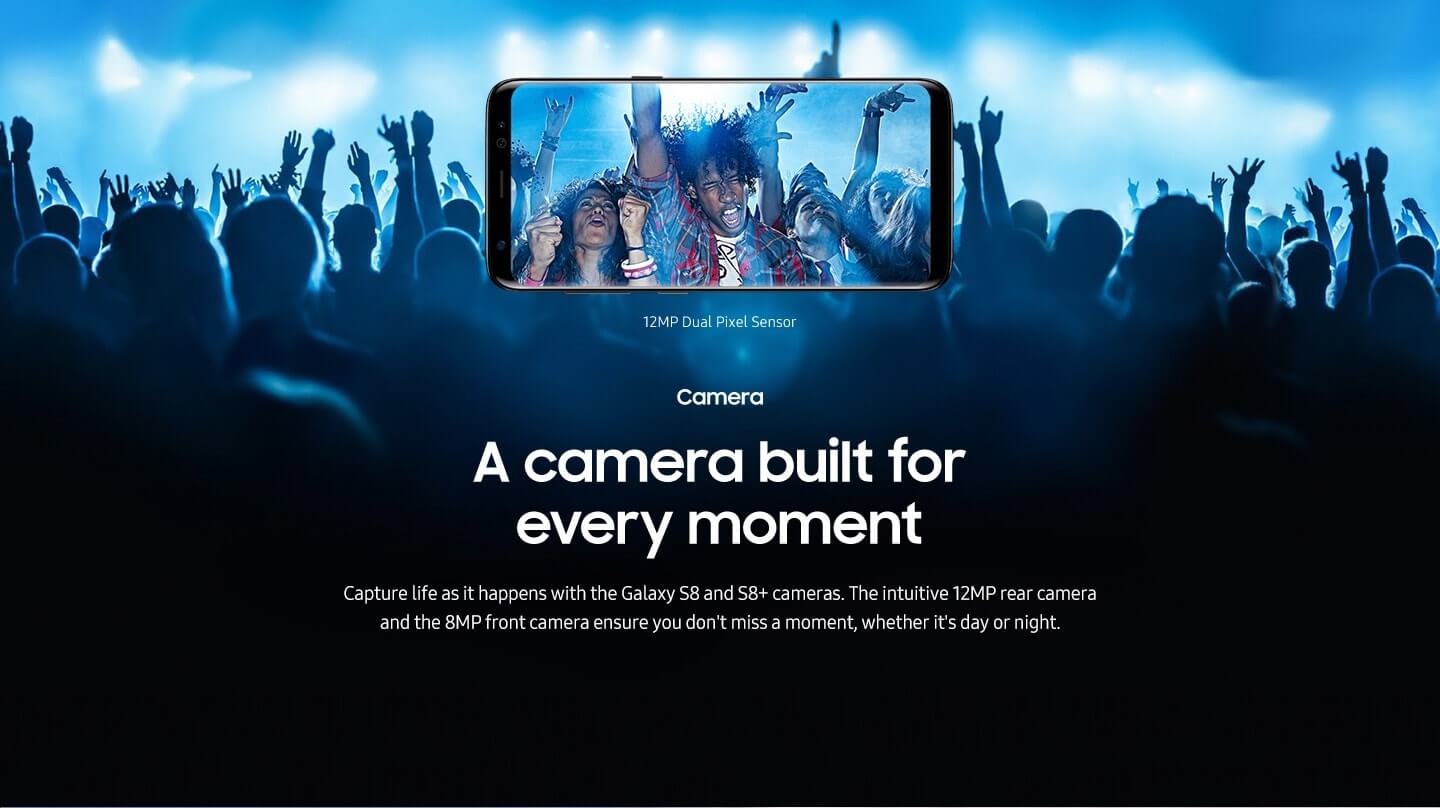
Logos Examples: This Samsung ad puts the Logos persuasive advertising technique to work.
Ever told someone to “listen to reason” during an argument? This is what logos does. The best logos advertisement examples are when a speaker appeals to logic.
Statistics, surveys, facts, and historical data can make a product seem like a more reasonable decision. Whether the data is sound or not is another story...
LOGOS EXAMPLE IN COMMERCIALS
Logos advert case study.
If you want a really strong example of logos is an advertisement, check out this shot list from a recent Nissan Commercial. You'll notice how the angles and shot size change when the "ProPilot" system clicks on:

Logos Advertisment Examples • Shot Listed in StudioBinder
This Nissan commercial shows a daughter and father driving on a highway. The daughter is about to drive past some scary construction, but then the father uses his sage like wisdom to instruct her to turn on the "ProPilot" system that Nissan now features in their cars.
Once the daughter does this, we see a Star Wars battle scene playing out in front of out eyes, and she becomes so distracted that she begin to veer off the road... but guess what? The "ProPilot" system saves her by auto-correcting the trajectory of the car based on the sensor system.
So how is this logos? Well, the commercial places the daughter in a relatively common situation and uses the machine logic behind having a guided system in the car to keep your distracted children safe.
Now... is it logical that this Star Wars homage suggests the daughter reach out to use the force by using a guided machine? Of course not! That's the opposite of what Luke does in the movie. Is it logical for your kid to be scared of driving past construction at 40mph? Of course not!
Is there anything in this spot that is logical? The basic fact that young drivers get distracted, and the Nissan "ProPilot" system might just save their lives one day, well that is how you use logic to sell cars.
LOGOS TECHNIQUES
How is logos being used in advertising.
Technology advertisements use logos because their goal is to showcase cool new features. Consider the example of logos in Apple’s advertisement for the iPhone X:
A logos advertisement example: In Apple’s iPhone X spot, the features pop out at you.
In logos rhetoric, you have to the sell best reasons to buy your product..
How does Apple do that?
They have their new innovative features pop out at you. From durable glass to Face ID software. It effectively asks you why you would choose any phone but iPhone. Logos often use buzzwords to sell the product.
What's a great example of this?
Food companies capitalizing on the rising demand for healthy choices.
Logos Examples: I Can’t Believe It’s Not Butter underscore organic and vegan offerings
This I Can’t Believe It’s Not Butter ad hinges on the two words “organic” and “vegan" to prove the point that they’re “made with the goodness of plants.” Of the types of persuasive techniques in advertising, logos will build your brand as the most logical, functional and helpful option.
- The Most Inspiring Ads That Every Agency Should See →
- Shot list your video with StudioBinder →
- Creative YouTube Video Ideas to Try on Your Channel →
Wrapping up ethos, pathos, logos
When browsing the many types of persuasive techniques in advertising, consider what your user needs from you. Then ideate on which technique can best fulfill that need.
As you’ve seen in these ethos, pathos and logos ads, the brand should guide how the persuasive advertising techniques are deployed. What is the company known for? What does it stand for?
Hopefully you’ve found a few striking examples to inspire you. If so, create a free moodboard to capture the look and feel you’re going for. And be sure to let us know your thoughts in the comments below!
Showcase your vision with elegant shot lists and storyboards.
Create robust and customizable shot lists. Upload images to make storyboards and slideshows.
Learn More ➜
- Pricing & Plans
- Product Updates
- Featured On
- StudioBinder Partners
- The Ultimate Guide to Call Sheets (with FREE Call Sheet Template)
- How to Break Down a Script (with FREE Script Breakdown Sheet)
- The Only Shot List Template You Need — with Free Download
- Managing Your Film Budget Cashflow & PO Log (Free Template)
- A Better Film Crew List Template Booking Sheet
- Best Storyboard Softwares (with free Storyboard Templates)
- Movie Magic Scheduling
- Gorilla Software
- Storyboard That
A visual medium requires visual methods. Master the art of visual storytelling with our FREE video series on directing and filmmaking techniques.
We’re in a golden age of TV writing and development. More and more people are flocking to the small screen to find daily entertainment. So how can you break put from the pack and get your idea onto the small screen? We’re here to help.
- Making It: From Pre-Production to Screen
- What is a Light Meter — Understanding the Photographer's Tool
- What is Metonymy — Definition, Examples & How to Use It
- What is a Short Story — The Art of Brevity in Literature
- What is an Action Hero — Best Examples & Defining Traits
- What is a Movie Spoiler — Types, Ethics & Rules Explained
- 57.8K Facebook
- 240 Pinterest
- 7.2K LinkedIn

- Supplier Optimizer
- Bundle Products
- Auto Sync Tracking Numbers
- Auto Update Order Status
- Stock Management
- More Features...
- AliExpress Dropshipping Service
- Shopify Dropshipping Service
- WooCommerce Dropshipping Service
- Wix Dropshipping Service
- DSers Jumpseller Dropshipping Service
- PayPal Order Tracking Service
- More Integrations...
- Help Center
- eCommerce Basics
- Dropshipping 101
- Partners Apps
- Chrome Extension
- WordPress Plugin
- Business Idea
- Dropshipping
- Ecommerce Guide
- Marketing Tips
- Niche Market
- Product Updates
What Is Persuasive Advertising - Definition and Examples
Arthur nelson.
We all know advertising is a crucial aspect of modern business and that it plays a vital role in the promotion and sales of products and services. Thus, in the past decade, a number of advertising methods have emerged - from programmatic advertising to ambush marketing on billboards, the list is too long.
Advertising surely serves as a medium for businesses to communicate with their target audience and persuade them to take a specific action, such as purchasing a product. One type of advertising that utilizes this persuasive approach is known as persuasive advertising.
What Is Persuasive Advertising
Persuasive techniques used in advertising, examples of persuasive advertising, wrapping up.
Persuasive advertising is a form of marketing that seeks to convince or sway people to take a specific action, such as making a purchase, by presenting arguments and information in a way that appeals to the target audience's emotions, values, beliefs, or needs.
This type of advertising often relies on techniques such as emotional appeals, testimonials, and humor to create a connection with the audience and drive them towards the desired action.
An umpteen number of techniques are used in persuasive advertising. Let’s delve deeper into some of them,
1. Emotional Appeal
Creating an emotional connection with the audience is a key element of persuasive advertising. This can be done through various techniques such as:
Storytelling: Using narrative and emotional storytelling to create a connection with the audience and evoke a desired emotional response.
Emotional appeals: Using images, music, and other sensory elements to evoke emotions such as happiness, fear, sadness, excitement, etc.
Personalization: Addressing the target audience directly and highlighting how the product or service can improve their life.
Social proof: With the help of testimonials, endorsements, or statistics, you can show that others have found success with the product or service.
Humor: Using humor to create a lighthearted and memorable connection with the audience.
2. Fear Appeal
Fear appeal is a persuasive advertising technique that uses fear to motivate people to take action. This can be done by highlighting potential dangers or consequences of not using the product or service being advertised.
For example, an advertisement for a home security system may use fear appeal by showing images of burglaries and emphasizing the need to protect one's family and property. Fear appeal is often controversial and can be seen as manipulative. It can also backfire if the fear elicited is too intense or perceived as unrealistic.
Therefore, it is important for advertisers to use fear appeal responsibly and ethically, ensuring that the fear being evoked is proportional to the issue being addressed and that the advertised solution is seen as a credible and effective solution.
3. Testimonials
Testimonials are statements or endorsements from satisfied customers or experts that are used in persuasive advertising to build credibility and trust for a product or service. They are a form of social proof, which is the idea that people are more likely to take action if they see others doing the same.
Testimonials can be in the form of following formats:
- Written quotes
- Video interviews
- Case studies
It can be anything that highlights the experiences and results of others.
When used effectively, testimonials can be powerful in persuading potential customers by demonstrating the real-life benefits of the product or service being advertised.
Advertisers should be careful to ensure that testimonials are genuine and representative of the typical experience of the target audience. Misleading or fake testimonials can damage a brand's reputation and credibility, so it's important to be transparent about the sources and selection process for the testimonials used in advertising.
4. Social Proof
“When you say it, it’s marketing, when they say it, it’s social proof” - Andy Crestodina, Co-founder & Chief Marketing Officer - Orbit Studios
Social proof can be a game-changer in marketing. In fact, according to research, it was found out, about 55% of online customers consider reviews to be very helpful.
People often look to the behavior of others as a guide for their own behavior, especially when they are uncertain or facing a new situation. By showcasing the popularity or endorsement of a product by others, marketers can leverage social proof to increase the perceived value and appeal of a product.
Examples of social proof in marketing include:
- Customer reviews and ratings
- User-generated content (e.g. social media posts)
- Celebrity endorsements
- Social media followers and likes
- User testimonials
- Case studies and success stories
- Expert endorsements
- Product usage statistics
However, it is important to note that the effectiveness of social proof can vary based on various factors such as the source of the proof, the target audience, and the type of product being marketed
5. Scarcity
Next in the list is scarcity, which plays on the human psychology of desire and urgency. By creating a sense of scarcity around a product or service, marketers can increase the perceived value and urgency to purchase, as people are more likely to act when they believe that an opportunity is limited or running out.
Examples of scarcity in marketing include:
- Limited time offers and sales
- Limited edition or exclusive products
- Limited availability of a popular product
- A countdown timer to create urgency
- A limited number of units available
- "Last chance" offers
The list goes on.
Similarly to social proof, it’s important to note that the effectiveness of scarcity can vary based on various factors. It includes the target audience, type of product being marketed, and the credibility of the scarcity claim.
6. Expert Opinion
People often place high trust in the knowledge and credibility of experts in a particular field. By endorsing a product or service, experts can help increase its perceived value and credibility, and provide valuable insights and information that can help potential customers make informed purchasing decisions.
There are various ways you can go about it. Following are a few of them:
- Celebrity endorsements from experts in a related field
- Testimonials from industry experts
- Endorsements from academic experts
- Quotes and interviews with experts in print and online advertisements
- Product reviews and recommendations from industry publications and websites
With that being said, let’s move to the examples of persuasive advertising and see how marketers out there are already making an impact with the same.
Following we have discussed how aforementioned persuasive techniques are used by the marketers.
Food and Beverage
By creating an emotional connection to healthy eating, such as highlighting the joy of cooking and sharing healthy meals with loved ones, marketers can make healthy eating seem more appealing and enjoyable. And this helps them meet their marketing goals.
Beauty and Personal Care
Emotional appeals can also be effective in beauty and personal care marketing. Here, marketers highlight the impact on self-confidence and personal goals.
This creates a powerful connection between the product and the individual's desires, leading to increased likelihood of purchasing. Marketers use emotional appeals, such as emphasizing improved self-confidence and personal benefits, to tap into people's emotions and drive purchasing decisions.
Technology and Electronics
Generally, testimonials work very well in this category. By featuring real customers who have had positive experiences with the product, companies can create a sense of trust and reliability in potential buyers.
Testimonials can also highlight key features and benefits of the product, helping to build interest and excitement. Including quotes, photos or videos of satisfied customers can make a big impact in convincing someone to make a purchase.
Real Estate
Here, the factor of scarcity usually comes into the picture. By emphasizing that there are only a few units available, real estate companies can create a sense of urgency and encourage potential buyers to act quickly. Highlighting the rarity and exclusivity of the properties can also increase their perceived value.
This marketing strategy works well for properties that are highly desirable and in high demand, as buyers may be more likely to make a purchase if they believe the opportunity to own such a property may not come along again.
Personal Finance
Lastly, personal finance is one of the sectors, where expert opinions come into the picture.
Using expert opinion can be a valuable tool in promoting financial products and services. By featuring endorsements from respected financial experts, companies can build credibility and trust with potential customers. Highlighting the expertise and experience of these individuals can help to demonstrate the quality and reliability of the products being offered.
Additionally, by offering advice and insights from experts, companies can position themselves as a trusted source of information and guidance in the financial world.
In the end, we’d like to mention persuasive marketing is not all about driving sales. It’s also about building a relationship with the customer by providing valuable information and demonstrating the benefits of a product or service.
Whether it's through television commercials, online ads, or print advertisements, effective persuasive advertising can be the key to success for any business looking to stand out in a crowded marketplace.
Latest Articles

10 Effective E-commerce Strategies to Boost Average Order Value

Dropshipping Delight: 8 Trending T-Shirt Niches to Consider in 2024

How to Identify Lucrative Dropshipping Niches: A Deep Dive
- • 10 Effective E-commerce Strategies to Boost Average Order Value
- • Can You Dropship Luxury Items in 2024: An Ultimate Guide
- • How to Find the Best Indie Brands for Dropshipping: A Comprehensive Guide
- • What to Dropship in the Second Quarter of 2024- A Noteworthy Discussion
- • Comprehensive Guide for Dropshipping Event Products in 2024
- • How Emojis Help Drive More Growth for Today’s Digital Marketing Landscape
- • Top 7 Must-Have Dropshipping Products to Beat the Heat in Summer 2024
- • How to Achieve Dropshipping Success: Your Must-Have Steps Checklist
- • How to Leverage AI in Dropshipping: Essential Tips and the Top Tools to Use
- • Why Health and Wellness Products Are in Demand in Dropshipping Ventures
京公网安备 11010502050693号
You are using an outdated browser. Please upgrade your browser to improve your experience.
Come on… Convince Me: Your Guide to Writing a Persuasive Text

What is a persuasive text?
A persuasive text is any text where the main purpose is to present a point of view and seeks to persuade a reader. A persuasive text can be an argument, exposition, discussion, review or even an advertisement.
How is a persuasive text structured?
A persuasive text is organised to include a ‘statement of position’, ‘arguments’ and a ‘reinforcement of position statement’
The statement of position gives an overview of the argument and reveals the position to be argued.
Next is the arguments section which is a series of points with supporting evidence. Here is where you try to convince the reader into believing your point of view on a particular issue. As a basis, you should have at least three main argument points and can include more if necessary.
After you have put forth your arguments you then need to sum up . In this section you will strongly repeat what you believe in with a summary of your argument points.
Get your students to have a crack at percussive writing using The Story Factory in Reading Eggs . It allows them to write and publish their own storybooks using an easy step-by-step guide.

Grammar and language conventions used
- Words with high modality , that is, words that show a high degree of certainty. For example – must, ought to, shall, has to. In comparison to words such as may, might, could and would that have low modality and show less certainty
- Emotive , descriptive words that appeal to the emotions. For example – wonderful, horrible, cruel, amazing, frightening, perfect
- A formal voice that is more authoritative and has more power of persuasion
- Repetition of words or phrases and concepts to push your point of view
- Connectives that help sequence your argument. For example – Firstly, Secondly
- Present tense
Use samples to increase understanding
If you are able to, find sample persuasive texts, grab a highlighter and start scanning them for main argument points, high modality words, emotive words and connectives. Working through a sample text is a great way to help you understand the general structure and sequence of a specific text.
Once you have deconstructed a sample text try writing a persuasive text yourself. You might want to have a friend write the opposing argument and you can compare afterwards.
Need help teaching literacy?
We’ve got you covered – read up on how to teach persuasive writing , check out the 5 ways you can bring literacy into ANY classroom , or choose from a range of free literacy resources below.
You might like...

20 Compelling Examples of Persuasive Copy in Online Advertising
Check out these click-worthy examples of persuasive copy for online ads. Discover why they work and how to test for persuasive ad copy.
The world of digital marketing makes it super easy for you to reach your target audience. But you have to whip up a mighty persuasive online ad if you want your prospects to click on yours. Persuasion is one of our CRO Agency secret weapons. It is layered into so much of what we do and is often the difference between beginners and conversion optimization experts .
In this post, we’ll review the definition of persuasive copy, how to make sure it works, and show you compelling examples of persuasive copy in online advertising.

Appeal to logic emotion and credibility all in one. Check out these click worthy examples of persuasive copy in online advertising.
What is Persuasive Copy
Persuasive copy can be defined as an argument that elicits a desired action from a relevant audience. Easier said than done, right?
Aristotle explained what constitutes persuasive copy best in his rhetorical appeals or ‘modes for persuasion’. Let’s keep in mind that his goal was to make his oratory (his presentations) more persuasive. And in doing so, he identified three types of persuasion appeals that are as valid today as they were back then.
- the appeal to reason, logic or logos
- the appeal to emotion or pathos
- and the appeal to one’s character, credibility or ethos
Not everybody makes a decision about a specific product or service based on the same argument. Purchasing a lipstick could be more of an impulse buy and an appeal to pathos or emotion may be the right call. Adding an appeal to reason such as “Free Shipping” may seal the deal and get you the click you desperately want.
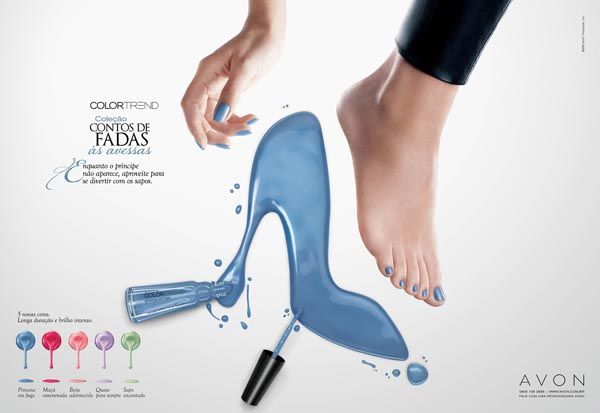
An example of emotionally persuasive copy in this Avon color trend nail polish, Fairytale collection: “Until your prince charming shows up have fun with the frogs.”
Avon color trend nail polish, Fairytale collection. The copy reads: “Until your prince charming shows up have fun with the frogs”. Why is this a prime example of persuasive copy in advertising? The famous Prince Charming in other countries, like Brazil and Italy, is called the “Blue Prince” — royal blue blood and all. So, until the blue one shows up, have fun with the rest of the colors. Clever emotional argument to leave the guilt behind and have fun now. If the shoe fits. ;)
Fortunately for most of us, developing persuasive copy is not an art but a data driven process. And as such, it can be tested.
How to Test Persuasive Copy in Online Advertising
As investment in digital advertising increases, it becomes essential to figure out what really works. Ad copy testing can be executed pre-campaign launch or while the campaign is live.
Some methods for online ad copy pre-testing may include focus groups, projective techniques, and recall tests. Performing these pre-tests ensures less spend is lost when it comes to activation.

Running an online ad campaign is costly. This is a different version of the Paypal for Business ad used to test the level of persuasiveness in the copy. What appeal has been dropped? Let us know in the comments section at the end of the post.
But the proof is in the pudding and nothing beats solid AB Testing to provide you with the metrics you need to define what’s really working. If you are looking to learn about testing persuasive copy, our blog is packed with articles that explain how to do this in detail. Check them out:
The Proven AB Testing Framework Used By CRO Professionals
4 Types of Useful AB Testing Tools You May Not Realize You Have
The AB Testing Process that Empowers Marketers
4 Mobile AB Testing Ideas that Worked for Our Clients
Or you can take our CRO Course and become a conversion specialist. Or if you’d rather have an experienced conversion agency power boost your online marketing spend and turn more of your ad clicks into revenue, check out our CRO for Advertising solutions .
And as we promised an article about compelling examples of persuasive copy in online advertising, let’s dive into them!
Why Is Persuasive Copy Crucial to Online Ads
Let’s assume you have the right ad placement, defined the perfect audience, and have properly identified what your audience responds to. After all, persuasive ad copy in and of itself is not the only factor that weighs in on a campaign’s success.
Is your ad copy missing the mark? Has your click through rate hit a new low?
We all want our online ads to influence our audience in such a way that they are inclined to click to call or click to buy from our website. But, what makes copy this convincing? Sometimes, actual examples of persuasive copy can guide us in crafting our own click-worthy online ads.
Compelling Examples of Persuasive Copy in Online Advertising
A genius way to apply emotion to a SaaS service on a Facebook ad for Litmus & dotmailer.
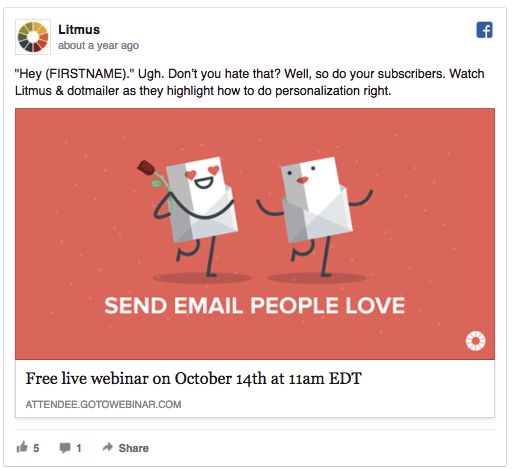
Examples of persuasive copy in online advertising help illustrate the concept.
Appeal to logic or logos works quite nicely for the auto insurance industry . I wonder what would happen to these click-through rates (CTRs) if they added some emotional arguments to the ad copy.
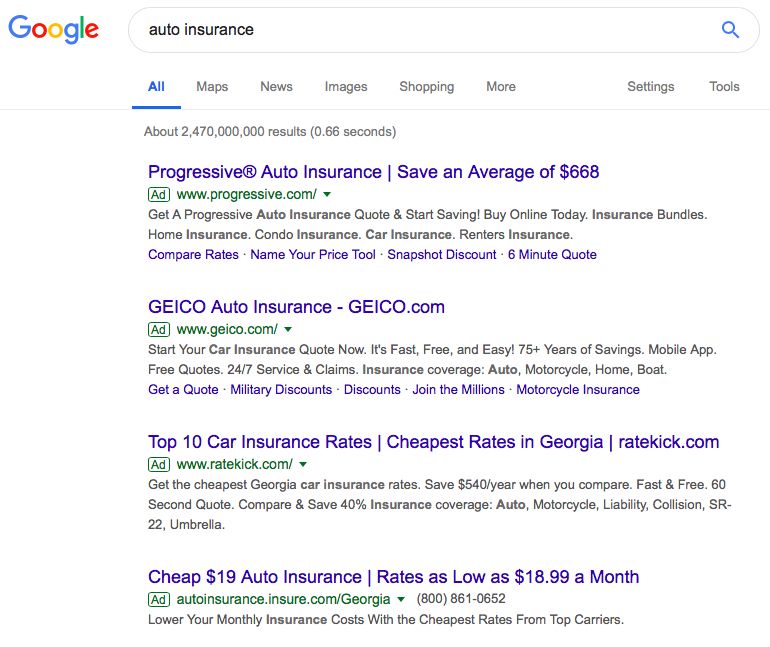
Auto insurance appeal to logic examples. They all look alike. Which one would you click on?
Finding examples of persuasive copy in advertising is simple if there is a Google Guarantee available. Not an easy addition to your online ads but worth every penny. All the credibility you want in a single line.
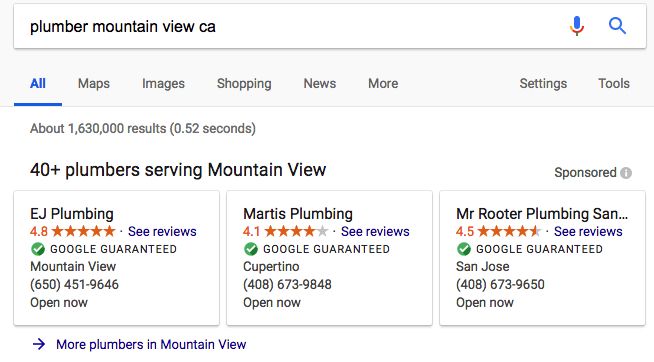
Building credibility through the Google Guarantee.
Ethos and logos appeal for this Facebook ad campaign.

Ethos appeal.
Lower the guilt with a logical argument. Less fat and less calories than your biggest competitor: McDonald’s french fries. How is that for an attention-getting example of persuasive copy?

Burger King fries ad copy. Stop clicking the button and keep reading!
Of course #FOMO is an emotion! This compelling example of persuasive copy in online advertising proves it! Almost depleted iPhone battery coupled with “Last Chance to Buy T&C Tickets” An example from a Digital Marketer Facebook ads campaign.
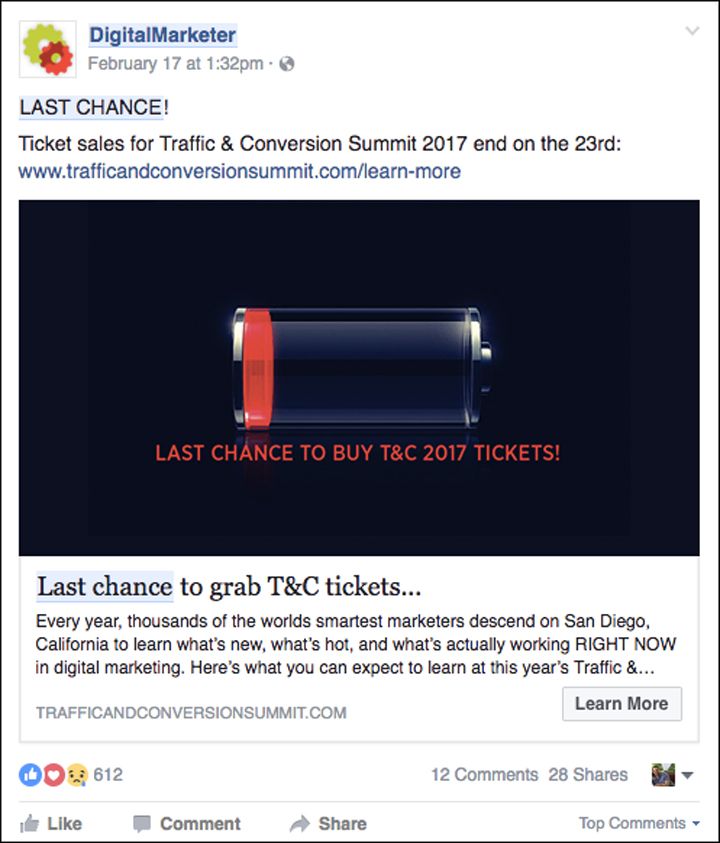
Appeal to emotion iPhone battery Facebook Ad example from Digital Marketer.
Searching for click-worthy examples of persuasive copy for your Facebook lead generation campaign ? A winner. Hands-down. No big emotional commitment. Only 8 hours for $500 and you get rid of those pesky projects.

Lead generation ad example targeting homeowners looking to start projects.
IBM Watson understands that their audience responds to reason. And that some may be ready to buy. The free trial is a highly persuasive method to get them to click on their ad.
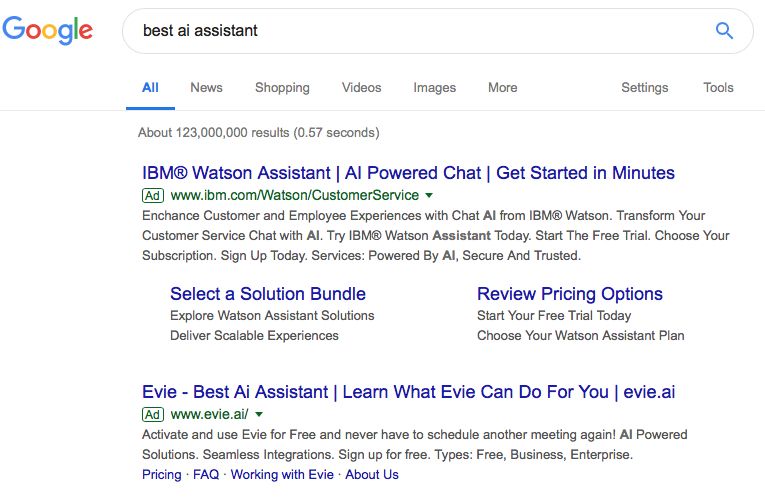
IBM Watson “free trial” a persuasive element of their offer.
This online ad for WD40 is all about persuading through pathos. You will need some WD40 to unstuck that scroll bar.

Humor, sex and curiosity are all emotional appeals.
Every once in a while, you run across an ad that you just can’t forget. Trident’s Facebook ad that appeals to emotions or pathos through some quirky logic as I am sure deodorant won’t taste like spearmint either.
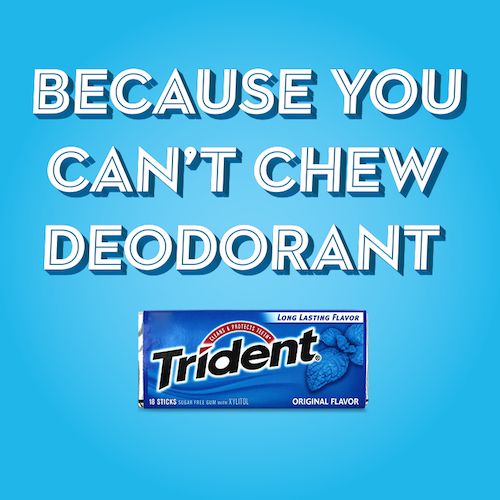
Example of emotional and logical appeal in persuasive copy for Trident’s online ads.
Although they usually resort to logic and ethos – 4 out of 5 dentists recommend – to craft persuasive copy.

Trident Coupons: Save money, prevent stains.
Sandwich delivery ads leverage a mix of ethos or credibility (reviews, how many served), logical (pricing and selection) and emotional (fresh, good, smells, comfort) elements. Definitely great examples of persuasive copy in PPC ads.

Sandwich delivery ads.
Pizza delivery examples of persuasive copy for Google Ads. One relies on logical and ethos vs emotional appeal.
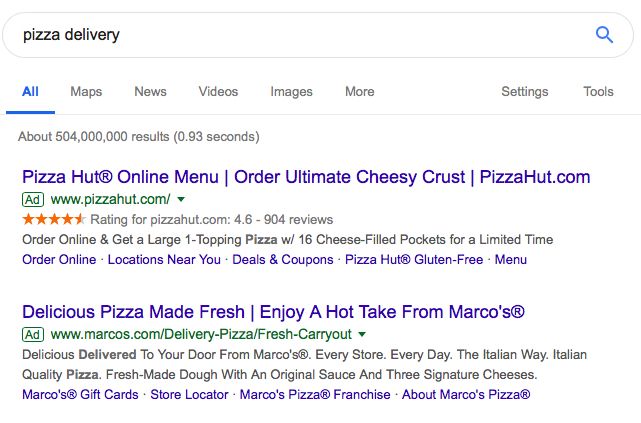
Logical and ethos vs emotional appeal for pizza delivery Google Ads.
Nike sneakers Google Ads: These are not Nike stores, so they lack the brand’s built in credibility. Therefore, they use pathos or emotional persuasion on the headline and ethos appeal on the body via the rating reviews and the on time delivery percentage.

Pathos or emotional persuasion on the headline and ethos appeal on the body via the rating reviews that give credibility and the ontime delivery percentage.
The Nike Official store, is all about logical persuasion of product availability with some additional credibility elements as message support.

Nike official store Google ad.
PPC ad copywriting for a mobile ad with emotional appeal. Click to call the luxury location of your choice.
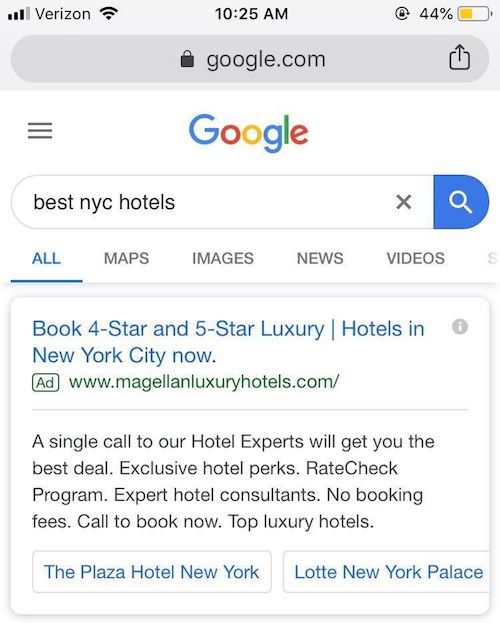
PPC ad for best NYC hotels. Luxury, of course.
So many persuasive reasons for that mileage traveler in you. Capital One Venture card uses ethos on their youtube and tv ads but not on their Google Ads. Here it’s all facts.
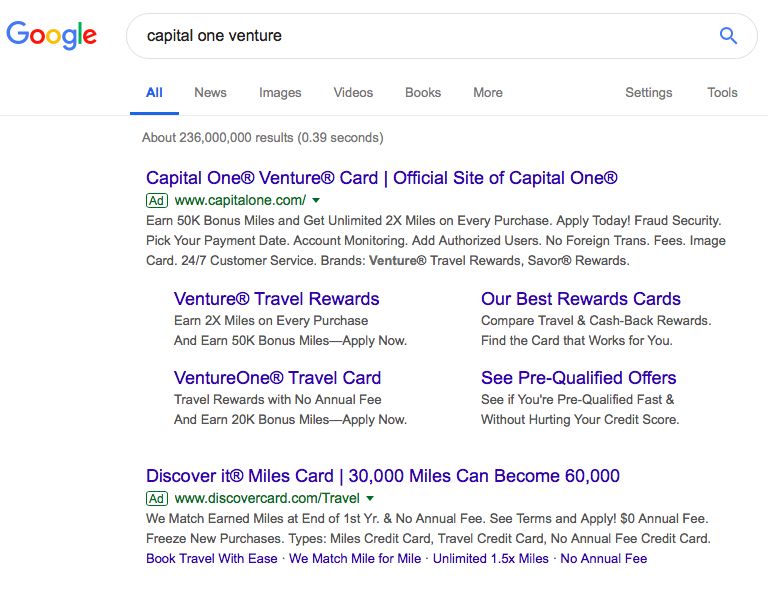
Capital One Venture card uses logos or logical appeal to persuade to click on this PPC ad.
I hope you found inspiration and ideas on these compelling examples of persuasive copy in online advertising. Now, discover how to Make Testimonials More Persuasive or sign-up to receive our weekly newsletter . Packed with great conversion optimization tips.
- Recent Posts
- 7 Simple & Effective Ways to Improve Your Email Open Rates - February 23, 2021
- The 3 Most Effective Marketing Strategies For Ecommerce Businesses - December 26, 2020
- Google Ads not Converting? Try These 4 Optimization Tricks - August 6, 2020
You might also like

Thank you Brian, for presenting one of MagellanLuxuryHotels.com PPC ads I wrote personally some time ago :-) Hope you remember me – we met a couple of times in CX Live conference in Austin?
Alex Suprun, Montreal, Canada
Yes, Alex. I do remember you. Did you make it to CXL this year?
Thanks for commenting.
Second PayPal ad dropped ‘credibility’ by removing the statistical element.
I suspect removing the statistic did reduce credibility for one segment of visitors. Humanists may have preferred the “choices” version in turn. Optimization is all about understanding your segments.
Thanks for the comment.
Amazing!! Thanks Brian for sharing this informative article. I do agree that its all about capturing your users’ attention with witty and quirky one-liners. These are some great examples to get started with, so thanks for this!!
Richard, “witty and quirky” can work to get attention. But our point is that you should consider all of the styles: “Logic, Emotion and Character”
Trackbacks & Pingbacks
[…] Here is a link to the origonal post: https://conversionsciences.com […]
Leave a Reply
Leave a reply cancel reply.
Your email address will not be published. Required fields are marked *
I agree to the terms and conditions laid out in the Privacy Policy

- Optimization Services
- Guaranteed Redesign
- Fully-managed CRO
- AI Optimization
- CRO Training & Coaching
- Conversion Solutions
- eCommerce Optimization
- Lead Generation Solutions
- CRO for Website Redesign
- CRO for Mobile Lead Gen
- CRO for Advertising
- About Conversion Sciences
- Success Stories
- CRO Resources
- Your Customer Creation Equation Book
- Free CRO Course
- CRO Calculator
- Press & Speaking Dates

This site uses cookies. By continuing to browse the site, you agree to our use of cookies. Or find out how to manage cookies .
Cookie and Privacy Settings
We may request cookies to be set on your device. We use cookies to let us know when you visit our websites, how you interact with us, to enrich your user experience, and to customize your relationship with our website.
Click on the different category headings to find out more. You can also change some of your preferences. Note that blocking some types of cookies may impact your experience on our websites and the services we are able to offer.
These cookies are strictly necessary to provide you with services available through our website and to use some of its features.
Because these cookies are strictly necessary to deliver the website, refusing them will have impact how our site functions. You always can block or delete cookies by changing your browser settings and force blocking all cookies on this website. But this will always prompt you to accept/refuse cookies when revisiting our site.
We fully respect if you want to refuse cookies but to avoid asking you again and again kindly allow us to store a cookie for that. You are free to opt out any time or opt in for other cookies to get a better experience. If you refuse cookies we will remove all set cookies in our domain.
We provide you with a list of stored cookies on your computer in our domain so you can check what we stored. Due to security reasons we are not able to show or modify cookies from other domains. You can check these in your browser security settings.
We also use different external services like Google Webfonts, Google Maps, and external Video providers. Since these providers may collect personal data like your IP address we allow you to block them here. Please be aware that this might heavily reduce the functionality and appearance of our site. Changes will take effect once you reload the page.
Google Webfont Settings:
Google Map Settings:
Google reCaptcha Settings:
Vimeo and Youtube video embeds:
You can read about our cookies and privacy settings in detail on our Privacy Policy Page.

How to Write an Advertisement: A Complete Guide for Students and Teachers
As with persuasive texts in general, advertisements can take many forms – from billboards and radio jingles to movie trailers and pop-ups on your computer.
In this guide, we’ll work towards writing a standard magazine-format advertisement known as the print ad. Print ads are text-heavy enough to provide something meaty for our students to get their teeth into. Though advertisers are increasingly overlooking print ads in favor of more trackable and often cheaper digital forms of advertising, the same strategies and techniques can apply to both.
Likewise, strategies such as emotive language and other persuasive devices are essential when writing ads. Much of the writing advice that follows applies to the other persuasive texts , which can also be found on our site. Be sure to check it out, also.
Let’s explore the structure and persuasive elements that make an advertisement successful. These elements combine to make us think and act favourably about a service or product. So let’s get into it and learn how to write an advertisement.
A COMPLETE UNIT ON ADVERTISING FOR TEACHERS & STUDENTS
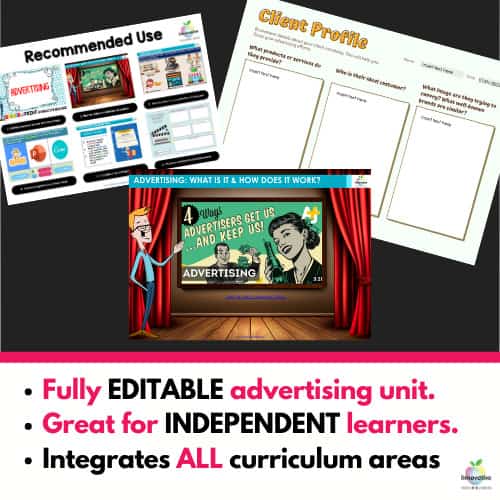
Teach your students essential MEDIA LITERACY SKILLS with this COMPLETE UNIT on ADVERTISING. It’s packed with ENGAGING, INFORMATIVE & FUN activities to teach students the persuasive techniques to READ ADVERTS and the skills to WRITE ADVERTS.
This COMPLETE UNIT OF WORK will take your students from zero to hero over FIVE STRATEGIC LESSONS covered.
PERSUASIVE TECHNIQUES TUTORIAL VIDEO (2:20)

STRUCTURE AND FEATURES OF ADVERTISEMENTS (PERSUASIVE ELEMENTS)
For students to create their own advertisements and successfully employ the various persuasive techniques, they’ll first need to develop a clear understanding of an advertisement’s underlying structure. We’ll explore the primary structural elements and features of advertisements, though the order of how these appear varies from advert to advert. Here, we’ll take a look at the following persuasive text elements.
- Call to Action

THE BRAND NAME AS A PERSUASIVE ELEMENT
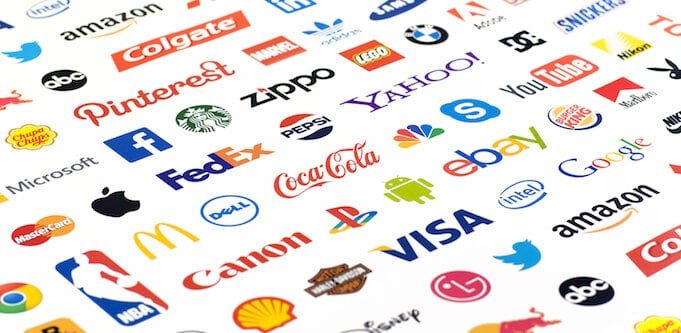
The brand name of the product or service frequently comes at the top of the advertisement – though not always. One of the first tasks for students when writing their own advertisement is to decide on a name for their product or service.
Please encourage students to select a name that reflects the product, service, or values they wish to present to their audience.
Brand names have evolved from being wordy and aspirational to very short and snappy since the inception of the internet, so they can be found easily on a search engine.
BRAND NAME CONSIDERATIONS
- What are the names of similar already existing products or services?
- Does the name look and sound good?
- Is the name short, punchy, and memorable?
- Does it evoke a feeling or an idea?
- Is it distinctive and original?
THE AUDIENCE AS A PERSUASIVE ELEMENT

An advertisement’s target audience may not always be immediately apparent and often needs to be inferred through language and imagery choices made by the writer.
However, who the target audience does need to be decided before writing as it will inform subsequent choices on the use of language (e.g. pronouns, tone, etc.) and imagery.
There are several ways to help students determine their target audience. A good starting place is for them to consider creating a target persona, a fictional character who represents the type of person their product or service is aimed at.
- Education level
- Marital status
- Likes/Dislikes
- Who they trust
- What they read/watch
An effective print advertisement presents a product or service in an appealing manner. It quickly conveys essential information about that product or service. It will include a clear and specific offer and also provide the information required for the reader to act on that offer.
Once we have the brand name sorted and the audience defined, it’s time to look at the critical structural elements to consider when writing an ad. It’s important to note that not every element will be used in every ad, but the following model serves well for writing most print advertisements.
THE HEADLINE AS A PERSUASIVE ELEMENT
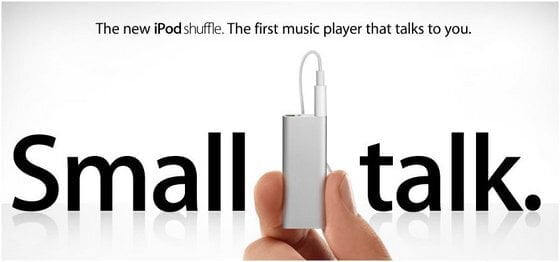
The ad headline should provide a short, snappy preview of what the reader will find in the copy. A good headline grabs the potential customer’s attention and makes them want to read the rest of the ad. There are several tried and tested means of writing a good headline. Here are 3 of the most effective:
The Problem/Solution Headline – This headline details a problem a potential customer may be facing and offers the solution in the form of the product or service. For example: Tired? Sluggish? Overweight? Excero Bike Gets You Where You Need to Go, Fast!
The Testimonial Headline – This headline uses a quote from a customer’s positive review to help sell the product or service. The testimonial allows the potential customer to see some ‘proof’ upfront before buying. “With the Excero Bike, I lost 15lbs in 15 days. I’m now thinner, fitter, and much, much happier!”
The Question Headline – This headline asks a question that the target customer will be seeking an answer to, for example, “Are you paying too much for your x?” Are You Paying Too Much for Your Gym Membership?
THE LOGO AS A PERSUASIVE ELEMENT
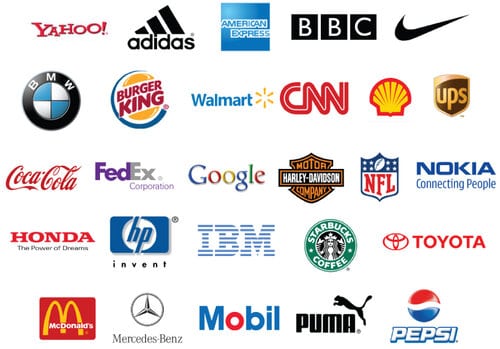
Logos are visual representations of a brand and are used to help promote a range of products and services under a single umbrella and also to allow for quick identification by the reader. They are more of a design element than a writing one.
THE SLOGAN AS A PERSUASIVE ELEMENT
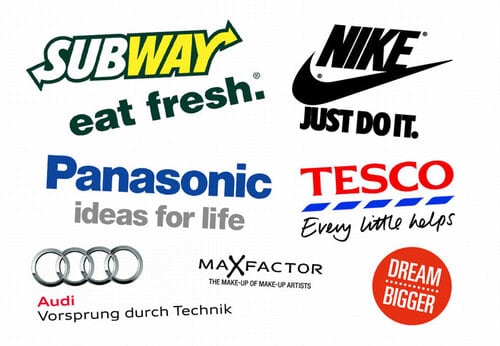
A slogan is a phrase or a short sentence used to represent or sell a particular brand. Usually, they’re designed to be short and snappy to help make them more memorable for readers. Slogans often use alliteration, rhyme, puns, or other figurative language techniques to make their message more memorable.
THE OFFER AS A PERSUASIVE ELEMENT
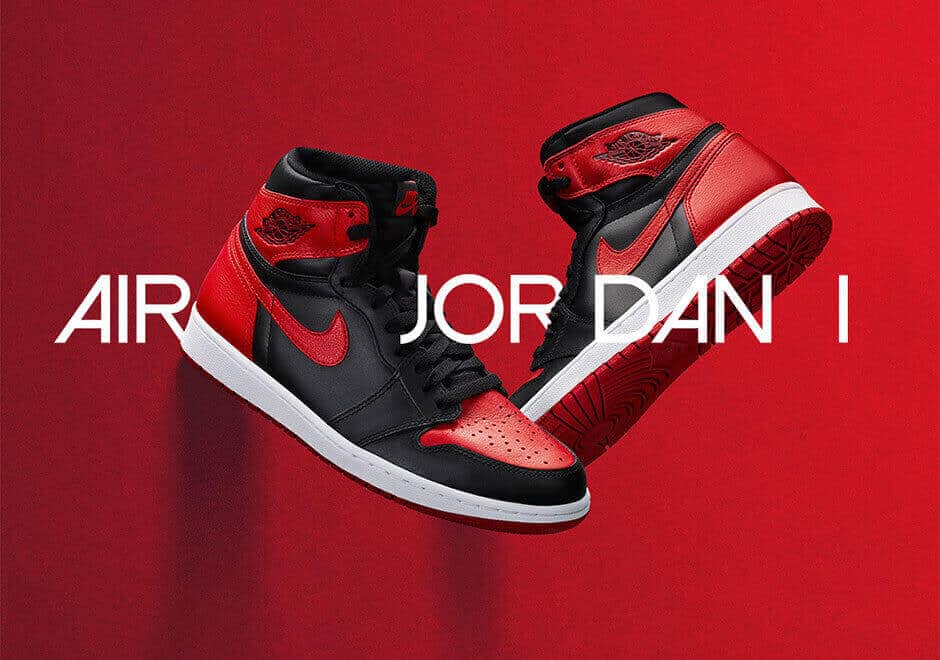
A good print ad makes readers an offer. This is usually in the form of a benefit the potential customer will gain or a motivating reason for finding out more about the product or service.
The Offer acts as a ‘hook’ that maintains the reader’s focus and draws them into the body of the ad. It can take the form of a time-limited discount or a 2-for-1 offer, etc. This Week Only – 25% Off!
Offers can also form part of the Call to Action at the end of the ad – more details on this soon.
THE BODY COPY AS A PERSUASIVE ELEMENT
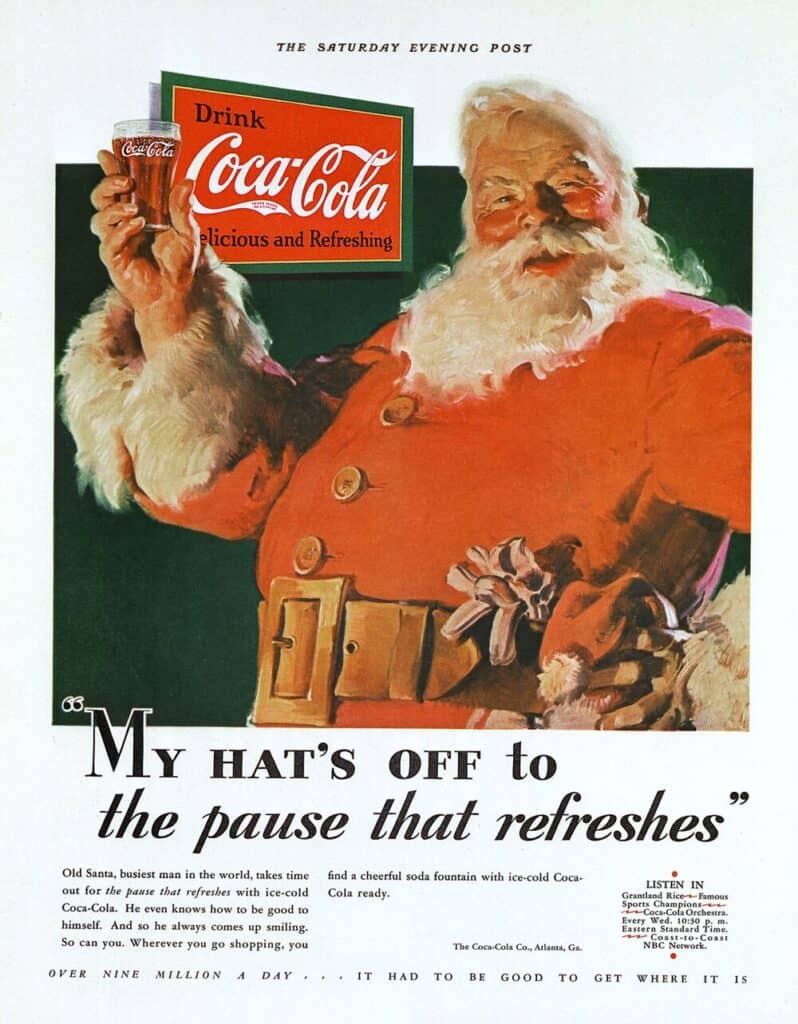
Good body text (or body copy) in an ad is well-organized and quickly gets to the point. Readers want to get the necessary information with minimum effort. For the writer, this requires skill, patience, and much editing. There are several different types of body copy that students need to consider when writing their ads. Let’s take a look at 5 of these:
Factual – Factual copy gives the reader just enough factual information about the product or service to persuade them that it’s worth buying.
Humor – Using humor is a tried-and-tested means of making an ad memorable. To use it successfully, students will need to have an excellent understanding of their target audience.
Narrative – This copy tells a story as a way to draw the customer in. Many people are resistant to direct selling. Narrative copy uses the power of storytelling to build a connection with the customer to ‘soft sell’ to them.
Testimonial – While testimonial content usually comes from a customer, it can also come from experts, celebrities, or any kind of spokesperson. The testimonial is based on what the customer or spokesperson liked about the product or service. Testimonials are often woven into the humanity of the ad. This copy appeals to emotions. Rather than boasting directly of the benefits of the product or service, this type of ad evokes the senses and appeals to emotions.
The body copy might include details of available products or services, special offers, or specific information the advertiser wants potential customers to know. Subheadings and bullet points can help organize the text and make information easier to find. Texts should be short and easy to read. Walls of text can be off-putting; if the language is too complex, it may turn off potential customers.
THE CALL TO ACTION AS A PERSUASIVE ELEMENT

The Call to Action or CTA frequently comes at the end of the advertisement. It’s usually made up of a few sentences that invite the reader to take a specific action. This action might take the form of buying the product, sharing contact information, or, in the case of an online ad, clicking on a link to find out more about the product or service.
Call to action Contexts:
- An electronics company encouraging readers to buy their new computer
- A helpline requesting readers to call a number
- A political party urging readers to vote for them in an upcoming election
- A travel agent appealing to readers to book
- A travel agent appealing to readers to book their next holiday through them
There are many ways to write a CTA but some effective strategies that are commonly used include:
- Start with strong action words urging the reader to take action, e.g. Join, Discover, Order, Subscribe, Buy , etc.
- Let the reader know precisely what you want them to do.
- Ensure the necessary contact details are included, e.g. address, email, website address, phone numbers, etc.
- Motivate the reader to take action through the use of promotional offers, e.g. Get 50% off or Book your free consultation today!
- Provide a reason to take action by communicating the benefits, e.g. Losing weight, Saving money, Performing better, etc.
- Use numbers to appeal to the reader, e.g. Save 20% on your next video, Now with 33% extra free! etc.
- Make your audience an offer they can’t refuse, e.g. Book Your School Marketing and Promotion Analysis today – No Strings Attached.
- Create a sense of urgency by limiting a special offer in some way, e.g. 25% off for the first 100 customers, Free T-shirt if booked today, Buy 2 get 1 free this month only , etc.
PERSUASIVE DEVICES
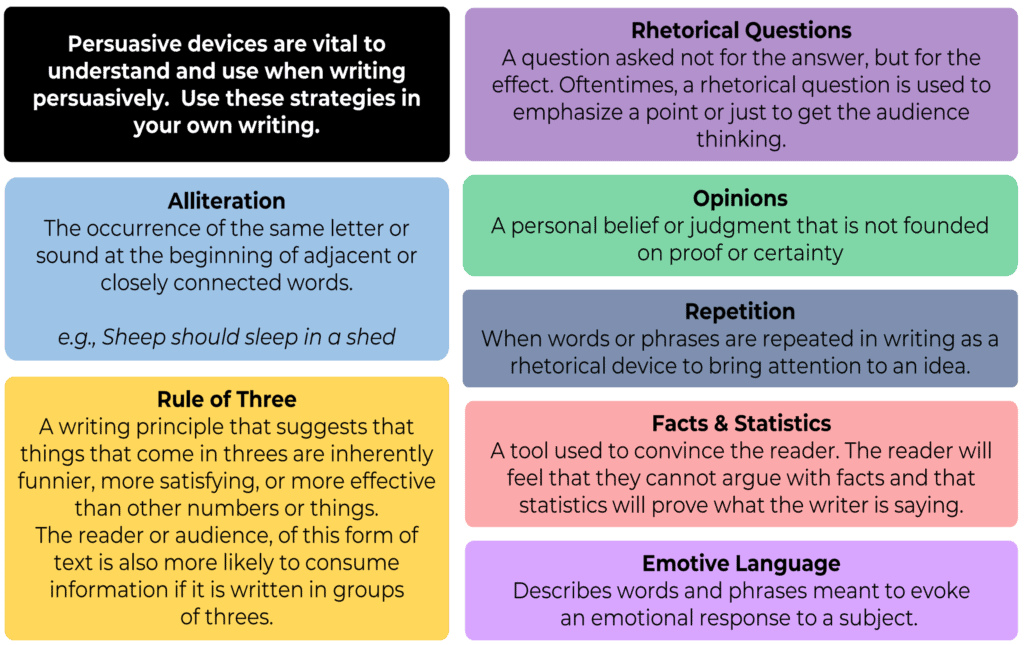
The use of persuasive devices is an essential aspect of writing an advertisement. Our students must clearly understand the following strategies to confidently produce an advertisement that works.
ALLITERATION IN ADVERTISING
This is a literary device that involves the repetition of the initial letter or sound of consecutive words or words near each other. It’s more commonly associated with poetry than nonfiction text types; however, it is also a popular technique used in advertising. Alliteration can help make brand names more memorable. Examples abound, e.g. PayPal, Coca-Cola, Range Rover, and Krispy Kreme, to name but a few.
It’s not just in company names that you’ll find alliteration at work, though. We can also see alliteration alive in slogans such as:
The best four by four by far – Land Rover
Made to make your mouth water – Opal Fruits
Greyhound going great – Greyhound
Don’t dream it. Drive It. – Jaguar
EMOTIVE LANGUAGE
Using emotive language involves deliberately choosing words to provoke an emotional response in the reader. Different ways exist to express the same idea.
We can choose to put a positive, neutral, or negative spin on the same event through the words we select. For example:
Positive: She triumphed gloriously against stiff competition in the spelling bee.
Neutral: She won the spelling bee.
Negative: She received first prize in the poorly attended minor-league spelling bee.
Asking questions can help to engage the reader and persuade them to come to the desired conclusion by themselves. This is the ad equivalent of the ‘show, don’t tell’ mantra employed by fiction writers.
As with all the techniques and strategies, this technique must be used with care. It can have the opposite of the desired effect, such as building resistance in the reader, if used carelessly. Students should avoid making hyperbolic suggestions with their rhetorical questions. For example, the question “Want to lose 50lbs in 2 weeks?” implies a highly exaggerated claim that most intelligent readers will not believe. In this instance, the rhetorical question detracts from the ad’s effectiveness rather than enhances it.
The most important thing for students to remember when using this technique is that they should only ask rhetorical questions in their ads when they can predict with a reasonable degree of certainty what the answer will be in the reader’s mind. Nine times out of ten, that answer should be a simple yes. Questions should be straightforward, as should the answers they generate.
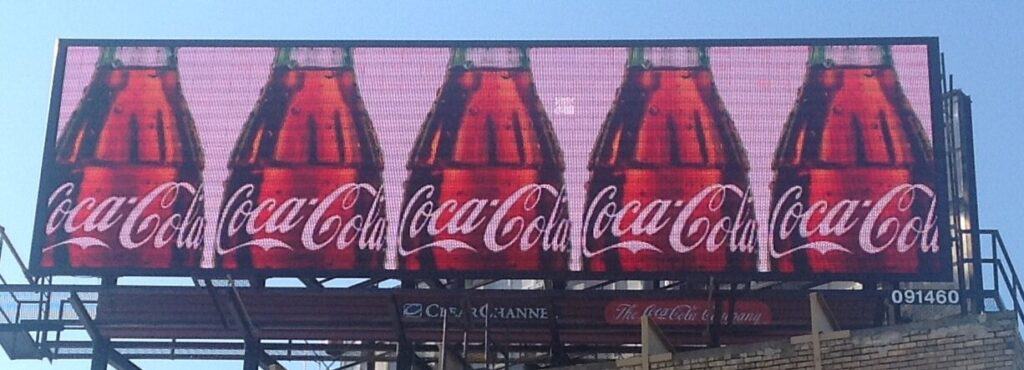
Advertisers know that we usually need to see or hear things several times before we’ll remember them. Also, the reader is more likely to believe something true the more frequently they hear it. For these reasons, advertisements rely heavily on repetition to drive their message home.
In advertising, the repetition of certain keywords or phrases is used to emphasize a specific idea or emotion. When used well, it can increase the overall effectiveness of an ad. However, students should be careful not to bore the reader. Repetition should always be used strategically.
Repetition doesn’t just involve the repeating of words. It can also include repeating colors and images.
Here are some examples of repetition at work.
ADVERTISING WRITING TIPS FOR STUDENTS
- Carefully Consider the recount TYPE and AUDIENCE before writing.
- Keep the title simple, e.g. My First Day at High School
- Organize the text using paragraphs, e.g. a new paragraph for each section. Use the first orientation paragraph to set the scene by introducing characters, setting, and context.
- Write the recount in chronological order – the order in which things happened and keep it in the past tense – relating events that have already happened.
- Choose the correct perspective from which to write the recount, e.g. personal recounts will be told from a first-person perspective (e.g. I, me, etc.). Factual recounts are most often told from the third-person perspective (e.g. she, he, they, etc.).
- Use time connectives to help organize the text and link the different sections of the recount together.
- Avoid repetitive use of language like then x, then y, and then z.”
- Aim to draw the reader into the action by using descriptive and figurative language
- Focus on the most critical/exciting parts.
- Use plenty of detail but ensure it is relevant to the purpose of the recount.
PERSUASIVE VOCABULARY
Vocabulary can elicit an emotional response beyond the literal meaning of the words used. When students understand this, they understand a powerful tool of persuasion.
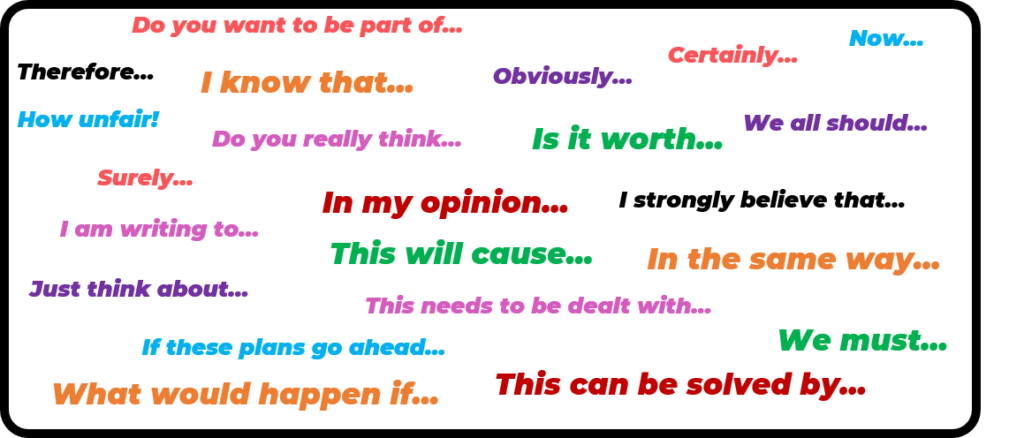
PERSUASIVE ADVERTISING STRATEGIES

The Pain Solution: Persuades by highlighting a problem and suggesting a solution.
The Bandwagon: Persuades to do, think, or buy something because it is popular or because “everyone” is doing it.
The Testimonial: Persuades by using a previous customer or famous person to endorse a product or idea.
The Logical Appeal: Persuades by using reason, usually in the form of a claim backed by supporting evidence.
The Emotional Appeal: Persuades using words that appeal to emotions instead of logic or reason.
The Youth Appeal: Persuades by suggesting you’ll feel younger and more energetic using this product or service.
The Romantic Appeal: Persuades the reader by invoking the powerful and inspiring feelings of love.
The Empathy Appeal: Persuades the reader by encouraging them to identify with the plight of another.
The Testimonial: Persuades the reader by using a previous customer or famous person to endorse a product or idea
THE ROLE OF IMAGES IN AN ADVERTISEMENT
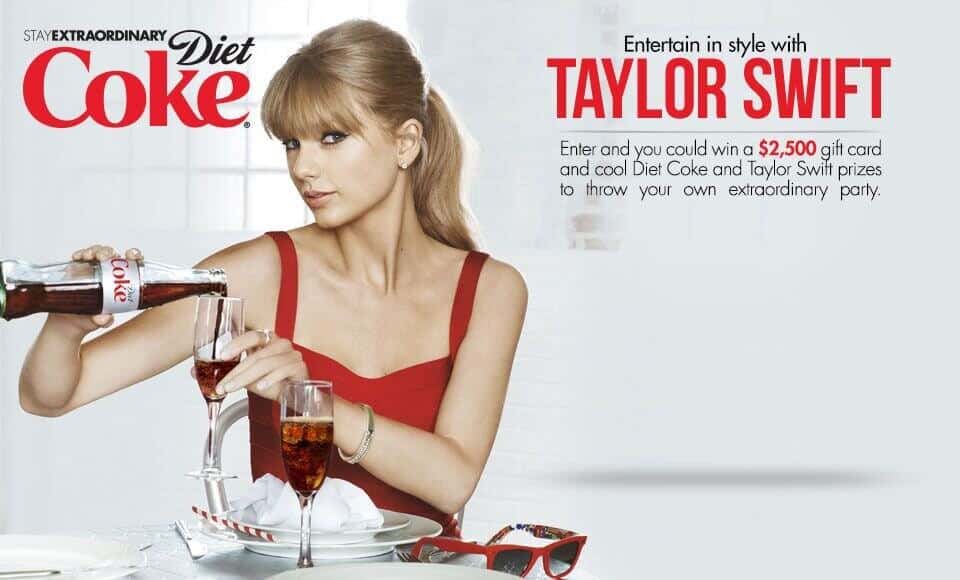
It’s a competitive world out there! Advertisements must catch and hold attention in an overwhelmingly noisy world, and images are a powerful means of doing this. Photos, pictures, diagrams, logos, color schemes – the visual look of an ad is as important as the text and, in some cases, more important!
Interesting images capture interest. They can intrigue the reader and encourage them to read the text they accompany.
Images also help the reader visualize the product or service offered. Advertising space can be expensive, and, as the old adage has it, a picture tells a thousand words. Images help advertisers make the most of their advertising real estate.
Students should carefully choose (or create) images to accompany their text. They should ensure that images are relevant and appropriate for their selling audience. They should look natural and genuine rather than posed.
Students can create their own images using their cell phones or graphic designer apps such as Canva .
This is our complete guide on writing an advertisement for students, and be sure to browse all our persuasive articles whilst you are here. Finally, we also have a complete unit of work on advertising for students and teachers that can be found here.
PERSUASIVE DEVICES TUTORIAL VIDEO
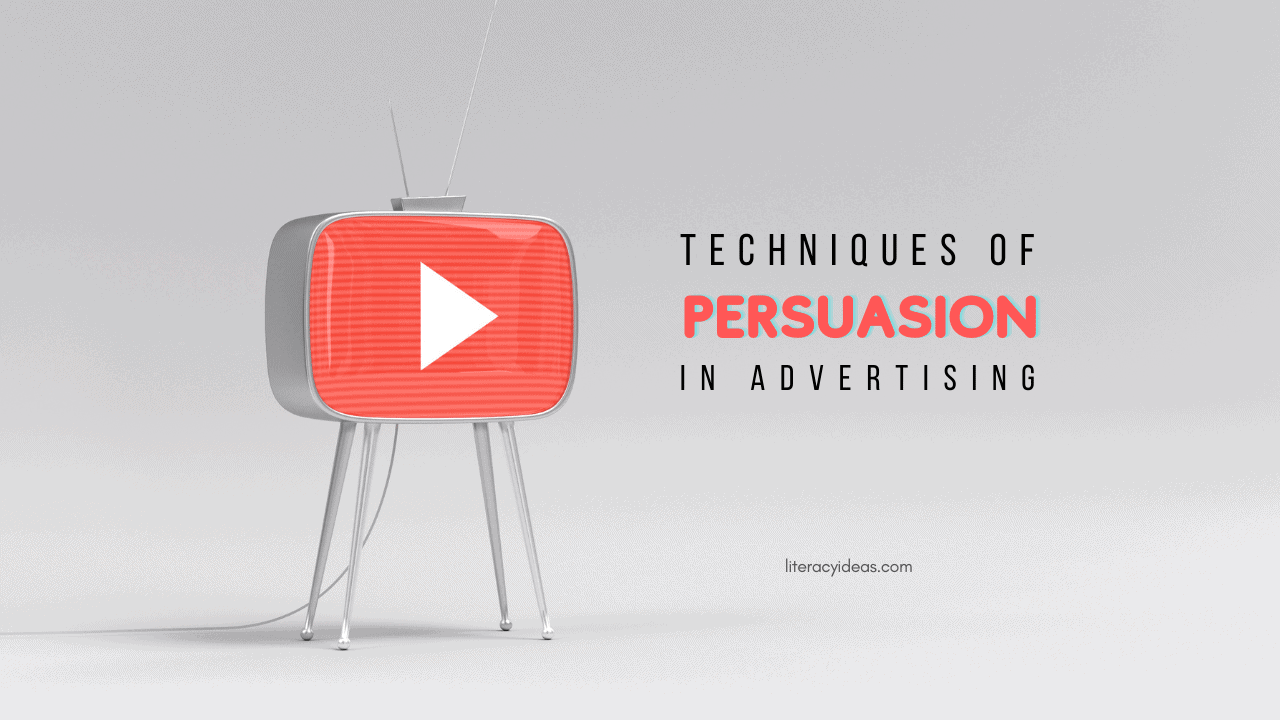
OTHER ARTICLES RELATED TO HOW TO WRITE AN ADVERTISEMENT

How to Write Perfect Persuasive Essays in 5 Simple Steps

Top 5 Persuasive Writing Techniques for Students

5 Top Persuasive Writing Lesson Plans for Students and Teachers

23 Persuasive writing Topics for High School students
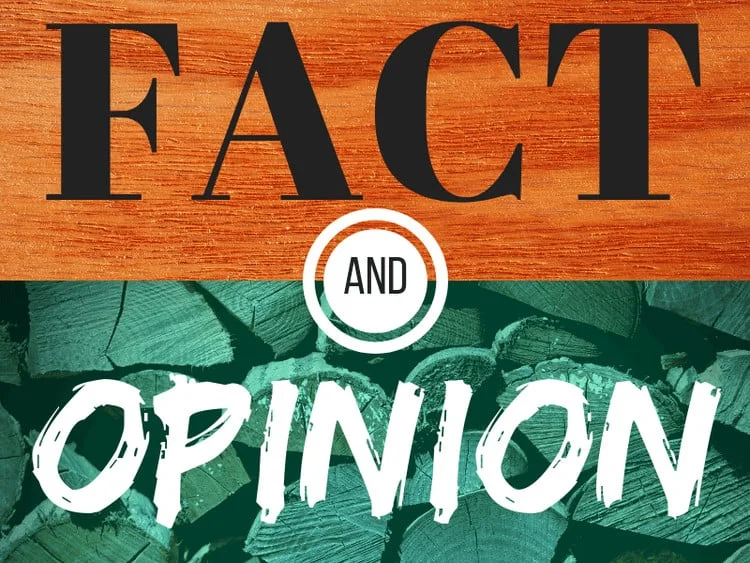
Teaching Fact and Opinion
- Self Confidence
- Public Speaking
- Communication
- Communication Skills
LEARNER STORIES
- Kanhaiya Sharma
- Ashfaq Sorathia
- Prateek Chawla
OTHER TOOLS
- Comparative Analysis

What is Persuasive Writing: Examples, Format and Style

On This Page
In a world brimming with information, persuasion is a valuable skill. Whether you’re a marketer aiming to sway consumers, a politician seeking votes, or a writer hoping to engage and inform, persuasive writing is your secret weapon. It’s the art of crafting words and arguments that convince, influence, and inspire action, presenting many persuasive writing examples to underscore your viewpoint.
Have you ever wondered what sets persuasive writing apart from the rest? How does it work, and why is it so powerful? In this blog, we’ll delve deep into the world of writing persuasive essays, exploring its techniques, psychology, and real-world applications, including persuasive writing examples. When you finish reading, you’ll understand the fundamentals and have the tools to apply persuasive writing in your endeavors.
So, let’s embark on a journey into the realm of words and ideas, where the power of persuasion awaits. Join us as we uncover the strategies and secrets behind compelling narratives and convincing arguments and learn how to master the art of persuasive writing.
Understanding Persuasive Writing
Persuasive writing is an art that shapes our decisions, beliefs, and actions daily. Whether convincing a friend to try a new restaurant, supporting a political candidate, or buying a product, persuasive elements are ever-present. To master persuasive writing, it’s crucial to comprehend the underlying psychology that drives it.
writers must understand how people think and make choices. One of the key foundations of writing persuasive essays is Aristotle’s three modes of persuasion: ethos, pathos, and logos. These principles are the building blocks of effective communication. Understanding and utilizing persuasive writing examples that incorporate ethos (ethical appeal), pathos (emotional appeal), and logos (logical appeal) can significantly enhance the impact of persuasive writing by appealing to the audience’s emotions, ethics, and reasoning.
Ethos involves establishing the credibility and authority of the speaker or writer. It’s about showcasing your expertise, trustworthiness, and authority on the subject matter. An audience is more likely to be persuaded by someone they perceive as a credible source. Exploring persuasive writing examples that effectively utilize ethos can provide a deeper understanding of how credibility and authority are established to influence an audience.
Pathos taps into emotions. It’s about crafting your writing to resonate with your audience’s feelings, values, and desires. Emotional appeal can be a potent tool in persuasion to convince the reader, as it forges a connection with readers on a personal level.
Logos employs logic and reasoning. It involves using evidence, data, and well-structured arguments to support your claims. A logically sound argument can bolster your persuasive efforts, especially when dealing with a rational or analytical audience.
In addition to these three principles, it’s important to recognize the role of cognitive biases in persuasion. Human brains often take cognitive shortcuts, resulting in biases that influence decision-making. By understanding these biases, such as confirmation bias, anchoring, and the bandwagon effect, writers can strategically shape their persuasive content to convince the reader to work with, rather than against, these cognitive tendencies.
Furthermore, the power of storytelling should not be underestimated. People are naturally drawn to write narratives. A well-told story can captivate, resonate, and persuade better than a dry recitation of facts. By weaving persuasive elements into a compelling narrative, writers can engage their audience on a deep, emotional level.
Persuasive Writing in Professional Life
Effective writing to write persuasive content is a versatile and significant tool in numerous professional scenarios. Whether in a corporate setting or freelancing, knowing how to wield the power of words can greatly enhance your career prospects and bring about desired outcomes. Here are five situations where persuasive writing is particularly effective:
1. Marketing and Advertising Campaigns

To write persuasive essays lies at the core of marketing and advertising efforts. Crafting compelling and engaging copy that resonates with the target audience can persuade consumers to purchase products, subscribe to services, or take specific actions. Successful marketers use persuasive language, storytelling, and emotion-evoking content to connect strongly with potential customers.
2. Business Proposals and Reports
When presenting business proposals, reports, or recommendations, a persuasive essay can make a substantial difference. Convincing stakeholders or decision-makers to endorse your ideas, allocate resources, or support your strategies often hinges on how effectively you can articulate the benefits and potential returns on investment.
3. Sales Emails and Correspondence

Sales professionals and account managers frequently employ persuasive writing techniques in their emails and client communication. Skillful use of persuasive language, personalized content, and the presentation of unique selling points can win over potential clients, retain existing customers, and close deals.
4. Job Applications and Resumes

In the competitive job market, a persuasive essay is vital for crafting attention-grabbing resumes and compelling cover letters. The ability to present your skills, experiences, and qualifications persuasively can help you stand out among a sea of applicants, ultimately securing interviews and job offers.
5. Public Relations and Crisis Management
Persuasive writing plays a crucial role in managing public relations and handling crises. Communicating effectively during challenging situations requires language that can restore trust, mitigate damage, and convey a sense of responsibility and accountability.
As we’ve explored the power of persuasive writing in professional life, let’s now delve into crafting a persuasive message for specific scenarios.
Crafting A Persuasive Message
Creating a persuasive message is an art that combines the mastery of language, psychology, and strategy. To write a great persuasive message, you need to consider various elements and techniques that can captivate and influence your audience effectively. Here are some techniques how:

Establish Compelling Statement
Your persuasive message should begin with a concise and powerful thesis statement. This statement serves as the core idea you want to convey to your audience. It should be clear, specific, and easily understood. For example, suppose you’re writing a persuasive essay on the importance of recycling. In that case, your thesis statement might be: “Recycling reduces waste and conserves resources, making it an essential practice for a sustainable future.”
Structure Your Arguments
The structure of your message plays a crucial role in how persuasive it is. Arrange your arguments logically, beginning with the strongest points and gradually leading to the supporting details. This structure not only reinforces your main thesis but also ensures your audience remains engaged. An effective structure guides the reader from their initial skepticism to a point of agreement or action.
Use Persuasive Language
Employ persuasive language and rhetorical devices to make your message more convincing. These include metaphors, analogies, vivid imagery, and emotionally charged words. For example, in a persuasive speech advocating for better healthcare access, you could use the metaphor, “Healthcare is the cornerstone of a strong, healthy society,” to evoke a powerful image.
Address Counterarguments
Acknowledging and addressing potential counterarguments in your message demonstrates that you’ve thoroughly considered the issue. Anticipating and refuting opposing viewpoints adds credibility to your argument and reassures your audience. For instance, if you’re advocating for a particular environmental policy, address common objections and provide compelling counterarguments to debunk them.
Engage Reader’s Emotions
One of the most powerful tools in persuasive writing is emotional appeal. Engage your audience’s emotions by telling relatable stories, sharing personal anecdotes, or using emotional language. Suppose you’re writing a persuasive message to encourage donations to a charitable cause. In that case, a heartwarming story about a beneficiary can resonate deeply with your readers and inspire them to take action.
Having discussed the art of crafting a persuasive message, let’s now shift our focus to the broader skill of developing persuasive writing for various professional contexts.
Developing Persuasive Writing
Mastering the art of persuasive writing requires practice, dedication, and a deep understanding of the key principles and techniques. Here are some essential steps to help you develop persuasive writing skills:

Understanding Your Audience
Start by researching your target audience. Understand their demographics, interests, and the concerns. Engage with your readers or listeners to gain insights into what motivates them and what matters most to them. Use surveys, social media, and other feedback mechanisms to gather information. Once you have a clear understanding of your audience, tailor your writing to address their specific needs and the desires. Speak directly to their concerns, values, and goals. Use language and examples of persuasive essays and writing that resonate with them, demonstrating empathy and a deep connection.
Compelling Storytelling
Study the art of storytelling. Read books and articles and listen to speakers known for their storytelling skills. Practice storytelling in various contexts, from personal anecdotes to fictional narratives. Weave stories into your writing to illustrate key points and connect with your readers emotionally. Craft narratives that evoke feelings and provide relatable examples of persuasive storytelling. A well-told story enhances the impact of your message.
Call To Action
Study successful examples of persuasive calls to action in various contexts, from marketing campaigns to political speeches. Understand the elements that make a call to action compelling and actionable. Practice creating calls to action in different scenarios. Conclude your piece with a strong and specific call to action. Clearly state what you want your readers to do, believe, or think after reading your content. Make it actionable and inspiring, motivating your audience to engage or take the desired steps.
Impact Of Persuasive Writing: Examples
The impact of persuasive essays extends far beyond the written words on a page or screen. It can potentially effect significant change, influence decisions, and shape opinions in various domains. Here’s a closer look at the profound impact of persuasive writing:

Shaping Public Opinion
Persuasive writing is a formidable force in shaping public opinion and influencing policy. Op-eds, research papers, and advocacy campaigns can sway lawmakers, prompting them to adopt new laws or regulations in alignment with the writer’s perspective. Additionally, a persuasive essay has a significant impact on how the public perceives issues, organizations, or individuals. Media outlets, public relations campaigns, and persuasive speeches play a vital role in generating both positive and negative public perceptions, which, in turn, can affect public behavior, from supporting a cause to boycotting a product.
Greta Thunberg’s Climate Change Speech (2019)
Greta Thunberg’s speeches on climate change have ignited a global movement. Her speeches are characterized by their passionate and urgent pleas for environmental action (pathos). Thunberg’s use of moral and ethical arguments, reinforced by her ethos as a young environmental activist, has spurred climate strikes and rallies worldwide, leading to increased awareness and calls for policy changes.
Effective Leadership
Persuasive writing is an indispensable tool for effective leadership. Leaders across various domains use persuasive communication to motivate their teams. Whether through an inspirational email, a compelling speech, or a well-structured persuasive essay, compelling writing fosters a shared sense of purpose, drives high performance, and encourages team members to embrace a common vision. Additionally, leadership’s persuasive writing plays a fundamental role in shaping an organization’s culture. By communicating core values, vision, and expectations through written messages, leaders contribute to a cohesive and thriving workplace culture, positively impacting team dynamics and overall success.
Barack Obama’s 2008 Inaugural Address
In his inaugural address, President Barack Obama used eloquent language and a message of hope and unity to inspire the nation. He appealed to the audience’s emotions (pathos) by emphasizing common values and dreams, fostering a sense of national purpose and unity (ethos).
Motivating Action
Persuasive writing is a catalyst for motivating action on multiple fronts. It is a driving force behind social change, as activists, NGOs, and grassroots organizations use persuasive content to mobilize individuals to take action, whether signing petitions, participating in rallies, or donating to causes they believe in. Additionally, persuasive essays are instrumental in personal growth and development. Self-help books, motivational articles, and life coaching resources harness persuasive language to inspire people to adopt positive behaviors, set and achieve goals, and lead healthier, more fulfilling lives.
Emma Gonzalez’s “We Call B.S.” Speech (2018)
Emma Gonzalez, a survivor of the Marjory Stoneman Douglas High School shooting, delivered a passionate speech advocating for gun control. Her speech combined personal anecdotes and data-driven arguments (logos) to emphasize the need for policy changes. The emotional impact of her speech (pathos) resonated with many and fueled the gun control movement, contributing to legislative reforms and activism.
Empower Yourself With Persuasion
In an era of information overload and constant communication, the ability to wield persuasive communication is a powerful tool that can transform your personal and professional life, so empower yourself with persuasion. Acquire the skills to express your ideas effectively, build authentic connections, and drive positive change. With the art of persuasion in your toolkit, you hold the key to leaving a lasting mark on the world and shaping your unique history.
By Rishabh Bhandari
How to give a persuasive presentation: techniques and proven framework, influence vs persuasion: what’s the real difference, what is persuasion: meaning, skills and examples.
Kapable © 2024
- TERMS OF USE
- PRIVACY POLICY
- Grades 6-12
- School Leaders
FREE Poetry Worksheet Bundle! Perfect for National Poetry Month.
40 Strong Persuasive Writing Examples (Essays, Speeches, Ads, and More)
Learn from the experts.

The more we read, the better writers we become. Teaching students to write strong persuasive essays should always start with reading some top-notch models. This round-up of persuasive writing examples includes famous speeches, influential ad campaigns, contemporary reviews of famous books, and more. Use them to inspire your students to write their own essays. (Need persuasive essay topics? Check out our list of interesting persuasive essay ideas here! )
- Persuasive Essays
- Persuasive Speeches
- Advertising Campaigns
Persuasive Essay Writing Examples

From the earliest days of print, authors have used persuasive essays to try to sway others to their own point of view. Check out these top persuasive essay writing examples.
Professions for Women by Virginia Woolf
Sample lines: “Outwardly, what is simpler than to write books? Outwardly, what obstacles are there for a woman rather than for a man? Inwardly, I think, the case is very different; she has still many ghosts to fight, many prejudices to overcome. Indeed it will be a long time still, I think, before a woman can sit down to write a book without finding a phantom to be slain, a rock to be dashed against. And if this is so in literature, the freest of all professions for women, how is it in the new professions which you are now for the first time entering?”
The Crisis by Thomas Paine
Sample lines: “These are the times that try men’s souls. The summer soldier and the sunshine patriot will, in this crisis, shrink from the service of their country; but he that stands by it now, deserves the love and thanks of man and woman. Tyranny, like hell, is not easily conquered; yet we have this consolation with us, that the harder the conflict, the more glorious the triumph. What we obtain too cheap, we esteem too lightly: it is dearness only that gives every thing its value.”
Politics and the English Language by George Orwell
Sample lines: “As I have tried to show, modern writing at its worst does not consist in picking out words for the sake of their meaning and inventing images in order to make the meaning clearer. It consists in gumming together long strips of words which have already been set in order by someone else, and making the results presentable by sheer humbug.”
Letter From a Birmingham Jail by Dr. Martin Luther King Jr.
Sample lines: “We know through painful experience that freedom is never voluntarily given by the oppressor; it must be demanded by the oppressed. Frankly, I have yet to engage in a direct action campaign that was ‘well timed’ in the view of those who have not suffered unduly from the disease of segregation. For years now I have heard the word ‘Wait!’ It rings in the ear of every Negro with piercing familiarity. This ‘Wait’ has almost always meant ‘Never.’ We must come to see, with one of our distinguished jurists, that ‘justice too long delayed is justice denied.'”
Civil Disobedience by Henry David Thoreau
Sample lines: “Even voting for the right is doing nothing for it. It is only expressing to men feebly your desire that it should prevail. A wise man will not leave the right to the mercy of chance, nor wish it to prevail through the power of the majority. There is but little virtue in the action of masses of men.”
Go Gentle Into That Good Night by Roger Ebert
Sample lines: “‘Kindness’ covers all of my political beliefs. No need to spell them out. I believe that if, at the end of it all, according to our abilities, we have done something to make others a little happier, and something to make ourselves a little happier, that is about the best we can do. To make others less happy is a crime.”
The Way to Wealth by Benjamin Franklin
Sample lines: “Methinks I hear some of you say, must a man afford himself no leisure? I will tell thee, my friend, what Poor Richard says, employ thy time well if thou meanest to gain leisure; and, since thou art not sure of a minute, throw not away an hour. Leisure is time for doing something useful; this leisure the diligent man will obtain, but the lazy man never; so that, as Poor Richard says, a life of leisure and a life of laziness are two things.”
The Crack-Up by F. Scott Fitzgerald
Sample lines: “Of course all life is a process of breaking down, but the blows that do the dramatic side of the work—the big sudden blows that come, or seem to come, from outside—the ones you remember and blame things on and, in moments of weakness, tell your friends about, don’t show their effect all at once.”
Open Letter to the Kansas School Board by Bobby Henderson
Sample lines: “I am writing you with much concern after having read of your hearing to decide whether the alternative theory of Intelligent Design should be taught along with the theory of Evolution. … Let us remember that there are multiple theories of Intelligent Design. I and many others around the world are of the strong belief that the universe was created by a Flying Spaghetti Monster. … We feel strongly that the overwhelming scientific evidence pointing towards evolutionary processes is nothing but a coincidence, put in place by Him. It is for this reason that I’m writing you today, to formally request that this alternative theory be taught in your schools, along with the other two theories.”
Open Letter to the United Nations by Niels Bohr
Sample lines: “Humanity will, therefore, be confronted with dangers of unprecedented character unless, in due time, measures can be taken to forestall a disastrous competition in such formidable armaments and to establish an international control of the manufacture and use of the powerful materials.”
Persuasive Speech Writing Examples
Many persuasive speeches are political in nature, often addressing subjects like human rights. Here are some of history’s most well-known persuasive writing examples in the form of speeches.
I Have a Dream by Dr. Martin Luther King Jr.
Sample lines: “And so even though we face the difficulties of today and tomorrow, I still have a dream. It is a dream deeply rooted in the American dream. I have a dream that one day this nation will rise up and live out the true meaning of its creed: We hold these truths to be self-evident, that all men are created equal.”
Woodrow Wilson’s War Message to Congress, 1917
Sample lines: “There are, it may be, many months of fiery trial and sacrifice ahead of us. It is a fearful thing to lead this great peaceful people into war, into the most terrible and disastrous of all wars, civilization itself seeming to be in the balance. But the right is more precious than peace, and we shall fight for the things which we have always carried nearest our hearts—for democracy, for the right of those who submit to authority to have a voice in their own governments, for the rights and liberties of small nations, for a universal dominion of right by such a concert of free peoples as shall bring peace and safety to all nations and make the world itself at last free.”
Chief Seattle’s 1854 Oration
Sample lines: “I here and now make this condition that we will not be denied the privilege without molestation of visiting at any time the tombs of our ancestors, friends, and children. Every part of this soil is sacred in the estimation of my people. Every hillside, every valley, every plain and grove, has been hallowed by some sad or happy event in days long vanished. Even the rocks, which seem to be dumb and dead as they swelter in the sun along the silent shore, thrill with memories of stirring events connected with the lives of my people, and the very dust upon which you now stand responds more lovingly to their footsteps than yours, because it is rich with the blood of our ancestors, and our bare feet are conscious of the sympathetic touch.”
Women’s Rights Are Human Rights, Hillary Rodham Clinton
Sample lines: “What we are learning around the world is that if women are healthy and educated, their families will flourish. If women are free from violence, their families will flourish. If women have a chance to work and earn as full and equal partners in society, their families will flourish. And when families flourish, communities and nations do as well. … If there is one message that echoes forth from this conference, let it be that human rights are women’s rights and women’s rights are human rights once and for all.”
I Am Prepared to Die, Nelson Mandela
Sample lines: “Above all, My Lord, we want equal political rights, because without them our disabilities will be permanent. I know this sounds revolutionary to the whites in this country, because the majority of voters will be Africans. This makes the white man fear democracy. But this fear cannot be allowed to stand in the way of the only solution which will guarantee racial harmony and freedom for all. It is not true that the enfranchisement of all will result in racial domination. Political division, based on color, is entirely artificial and, when it disappears, so will the domination of one color group by another. … This then is what the ANC is fighting. Our struggle is a truly national one. It is a struggle of the African people, inspired by our own suffering and our own experience. It is a struggle for the right to live.”
The Struggle for Human Rights by Eleanor Roosevelt
Sample lines: “It is my belief, and I am sure it is also yours, that the struggle for democracy and freedom is a critical struggle, for their preservation is essential to the great objective of the United Nations to maintain international peace and security. Among free men the end cannot justify the means. We know the patterns of totalitarianism—the single political party, the control of schools, press, radio, the arts, the sciences, and the church to support autocratic authority; these are the age-old patterns against which men have struggled for 3,000 years. These are the signs of reaction, retreat, and retrogression. The United Nations must hold fast to the heritage of freedom won by the struggle of its people; it must help us to pass it on to generations to come.”
Freedom From Fear by Aung San Suu Kyi
Sample lines: “Saints, it has been said, are the sinners who go on trying. So free men are the oppressed who go on trying and who in the process make themselves fit to bear the responsibilities and to uphold the disciplines which will maintain a free society. Among the basic freedoms to which men aspire that their lives might be full and uncramped, freedom from fear stands out as both a means and an end. A people who would build a nation in which strong, democratic institutions are firmly established as a guarantee against state-induced power must first learn to liberate their own minds from apathy and fear.”
Harvey Milk’s “The Hope” Speech
Sample lines: “Some people are satisfied. And some people are not. You see there is a major difference—and it remains a vital difference—between a friend and a gay person, a friend in office and a gay person in office. Gay people have been slandered nationwide. We’ve been tarred and we’ve been brushed with the picture of pornography. In Dade County, we were accused of child molestation. It is not enough anymore just to have friends represent us, no matter how good that friend may be.”
The Union and the Strike, Cesar Chavez
Sample lines: “We are showing our unity in our strike. Our strike is stopping the work in the fields; our strike is stopping ships that would carry grapes; our strike is stopping the trucks that would carry the grapes. Our strike will stop every way the grower makes money until we have a union contract that guarantees us a fair share of the money he makes from our work! We are a union and we are strong and we are striking to force the growers to respect our strength!”
Nobel Lecture by Malala Yousafzai
Sample lines: “The world can no longer accept that basic education is enough. Why do leaders accept that for children in developing countries, only basic literacy is sufficient, when their own children do homework in algebra, mathematics, science, and physics? Leaders must seize this opportunity to guarantee a free, quality, primary and secondary education for every child. Some will say this is impractical, or too expensive, or too hard. Or maybe even impossible. But it is time the world thinks bigger.”
Persuasive Writing Examples in Advertising Campaigns
Ads are prime persuasive writing examples. You can flip open any magazine or watch TV for an hour or two to see sample after sample of persuasive language. Here are some of the most popular ad campaigns of all time, with links to articles explaining why they were so successful.
Nike: Just Do It

The iconic swoosh with the simple tagline has persuaded millions to buy their kicks from Nike and Nike alone. Teamed with pro sports-star endorsements, this campaign is one for the ages. Blinkist offers an opinion on what made it work.
Dove: Real Beauty
Beauty brand Dove changed the game by choosing “real” women to tell their stories instead of models. They used relatable images and language to make connections, and inspired other brands to try the same concept. Learn why Global Brands considers this one a true success story.
Wendy’s: Where’s the Beef?
Today’s kids are too young to remember the cranky old woman demanding to know where the beef was on her fast-food hamburger. But in the 1980s, it was a catchphrase that sold millions of Wendy’s burgers. Learn from Better Marketing how this ad campaign even found its way into the 1984 presidential debate.
De Beers: A Diamond Is Forever

A diamond engagement ring has become a standard these days, but the tradition isn’t as old as you might think. In fact, it was De Beers jewelry company’s 1948 campaign that created the modern engagement ring trend. The Drum has the whole story of this sparkling campaign.
Volkswagen: Think Small
Americans have always loved big cars. So in the 1960s, when Volkswagen wanted to introduce their small cars to a bigger market, they had a problem. The clever “Think Small” campaign gave buyers clever reasons to consider these models, like “If you run out of gas, it’s easy to push.” Learn how advertisers interested American buyers in little cars at Visual Rhetoric.
American Express: Don’t Leave Home Without It
AmEx was once better known for traveler’s checks than credit cards, and the original slogan was “Don’t leave home without them.” A simple word change convinced travelers that American Express was the credit card they needed when they headed out on adventures. Discover more about this persuasive campaign from Medium.
Skittles: Taste the Rainbow

These candy ads are weird and intriguing and probably not for everyone. But they definitely get you thinking, and that often leads to buying. Learn more about why these wacky ads are successful from The Drum.
Maybelline: Maybe She’s Born With It
Smart wordplay made this ad campaign slogan an instant hit. The ads teased, “Maybe she’s born with it. Maybe it’s Maybelline.” (So many literary devices all in one phrase!) Fashionista has more on this beauty campaign.
Coca-Cola: Share a Coke
Seeing their own name on a bottle made teens more likely to want to buy a Coke. What can that teach us about persuasive writing in general? It’s an interesting question to consider. Learn more about the “Share a Coke” campaign from Digital Vidya.
Always: #LikeaGirl

Talk about the power of words! This Always campaign turned the derogatory phrase “like a girl” on its head, and the world embraced it. Storytelling is an important part of persuasive writing, and these ads really do it well. Medium has more on this stereotype-bashing campaign.
Editorial Persuasive Writing Examples

Newspaper editors or publishers use editorials to share their personal opinions. Noted politicians, experts, or pundits may also offer their opinions on behalf of the editors or publishers. Here are a couple of older well-known editorials, along with a selection from current newspapers.
Yes, Virginia, There Is a Santa Claus (1897)
Sample lines: “Yes, Virginia, there is a Santa Claus. He exists as certainly as love and generosity and devotion exist, and you know that they abound and give to your life its highest beauty and joy. Alas! How dreary would be the world if there were no Santa Claus. It would be as dreary as if there were no Virginias.”
What’s the Matter With Kansas? (1896)
Sample lines: “Oh, this IS a state to be proud of! We are a people who can hold up our heads! What we need is not more money, but less capital, fewer white shirts and brains, fewer men with business judgment, and more of those fellows who boast that they are ‘just ordinary clodhoppers, but they know more in a minute about finance than John Sherman,’ we need more men … who hate prosperity, and who think, because a man believes in national honor, he is a tool of Wall Street.”
America Can Have Democracy or Political Violence. Not Both. (The New York Times)
Sample lines: “The nation is not powerless to stop a slide toward deadly chaos. If institutions and individuals do more to make it unacceptable in American public life, organized violence in the service of political objectives can still be pushed to the fringes. When a faction of one of the country’s two main political parties embraces extremism, that makes thwarting it both more difficult and more necessary. A well-functioning democracy demands it.”
The Booster Isn’t Perfect, But Still Can Help Against COVID (The Washington Post)
Sample lines: “The booster shots are still free, readily available and work better than the previous boosters even as the virus evolves. Much still needs to be done to build better vaccines that protect longer and against more variants, including those that might emerge in the future. But it is worth grabbing the booster that exists today, the jab being a small price for any measure that can help keep COVID at bay.”
If We Want Wildlife To Thrive in L.A., We Have To Share Our Neighborhoods With Them (Los Angeles Times)
Sample lines: “If there are no corridors for wildlife movement and if excessive excavation of dirt to build bigger, taller houses erodes the slope of a hillside, then we are slowly destroying wildlife habitat. For those people fretting about what this will do to their property values—isn’t open space, trees, and wildlife an amenity in these communities?”
Persuasive Review Writing Examples

Book or movie reviews are more great persuasive writing examples. Look for those written by professionals for the strongest arguments and writing styles. Here are reviews of some popular books and movies by well-known critics to use as samples.
The Great Gatsby (The Chicago Tribune, 1925)
Sample lines: “What ails it, fundamentally, is the plain fact that it is simply a story—that Fitzgerald seems to be far more interested in maintaining its suspense than in getting under the skins of its people. It is not that they are false: It is that they are taken too much for granted. Only Gatsby himself genuinely lives and breathes. The rest are mere marionettes—often astonishingly lifelike, but nevertheless not quite alive.”
Harry Potter and the Sorcerer’s Stone (The Washington Post, 1999)
Sample lines: “Obviously, Harry Potter and the Sorcerer’s Stone should make any modern 11-year-old a very happy reader. The novel moves quickly, packs in everything from a boa constrictor that winks to a melancholy Zen-spouting centaur to an owl postal system, and ends with a scary surprise. Yet it is, essentially, a light-hearted thriller, interrupted by occasional seriousness (the implications of Harry’s miserable childhood, a moral about the power of love).”
Twilight (The Telegraph, 2009)
Sample lines: “No secret, of course, at whom this book is aimed, and no doubt, either, that it has hit its mark. The four Twilight novels are not so much enjoyed, as devoured, by legions of young female fans worldwide. That’s not to say boys can’t enjoy these books; it’s just that the pages of heart-searching dialogue between Edward and Bella may prove too long on chat and too short on action for the average male reader.”
To Kill a Mockingbird (Time, 1960)
Sample lines: “Author Lee, 34, an Alabaman, has written her first novel with all of the tactile brilliance and none of the preciosity generally supposed to be standard swamp-warfare issue for Southern writers. The novel is an account of an awakening to good and evil, and a faint catechistic flavor may have been inevitable. But it is faint indeed; novelist Lee’s prose has an edge that cuts through cant, and she teaches the reader an astonishing number of useful truths about little girls and about Southern life.”
The Diary of Anne Frank (The New York Times, 1952)
Sample lines: “And this quality brings it home to any family in the world today. Just as the Franks lived in momentary fear of the Gestapo’s knock on their hidden door, so every family today lives in fear of the knock of war. Anne’s diary is a great affirmative answer to the life-question of today, for she shows how ordinary people, within this ordeal, consistently hold to the greater human values.”
What are your favorite persuasive writing examples to use with students? Come share your ideas in the WeAreTeachers HELPLINE group on Facebook .
Plus, the big list of essay topics for high school (120+ ideas) ..

You Might Also Like

101 Interesting Persuasive Essay Topics for Kids and Teens
Use your words to sway the reader. Continue Reading
Copyright © 2023. All rights reserved. 5335 Gate Parkway, Jacksonville, FL 32256
27 Most Persuasive TV Ads of All Time
Brands spend millions on 30-second ads because they know the return could be in billions. That’s the power of persuasion.
Almost every ad is created with the same intent and goal: to persuade the audience to trust the brand. And how the creatives spin a concept around that intent makes all the difference.
Today, we will take a look at the 27 most persuasive TV ads of all time and find out what makes them so influential.
The Top 27 Most Persuasive TV Ads of All Time
1. i want to buy the world a coke.
- Brand: Coca-Cola
- Agency: McCann Erickson
- Year: 1971
In our opinion, one of the best persuasive commercials is Coca-Cola’s “I Want to Buy the World a Coke”. Aside from the New Seekers’ catchy jingle, the ad is powerful because it focuses on the consumer rather than the product. This undoubtedly set a precedent for all future Coca-Cola campaigns.
Another factor that makes this one of the most influential TV commercials is the diversity of actors in the ad. This ad indeed established Coke as a universally beloved brand of soft drink.
With a budget of $250,000, it was the most expensive ad in its day. Initially released in Europe, the ad received a lukewarm response – but became a global phenomenon after massive success in the US.
2. 1984 Macintosh Computer
- Brand: Apple
- Agency: Fairbanks Films
- Year: 1984
Mac’s 1984 is an excellent example of ads that are persuasive. It’s almost as iconic as George Orwell’s literary masterpiece that it refers to. But, instead of the terrifying dystopia predicted by Orwell, Steve Jobs promises a better and brighter future – a future everyone wants. And this is how they created a commercial that touched the right chords with the audience obsessed with the Sci-Fi genre.
It won’t be wrong to say that the ad was as innovative as you’d expect any Apple product to be. Despite taking inspiration from someone else’s work, the concept is the epitome of sheer creativity. The ad is credited for redefining the art of corporate storytelling. Pay attention, and you will realize that there is a subtle dig on IBM, Apple’s biggest competitor at the time.
This 30-second ad, costing $1.5 million at the time, was directed by Ridley Scott and was watched by 97 million Americans during Superbowl. And that is how the Mac was born.
Related reading, “ 100 Most Famous Paintings Of All Time “.
3. We All Win
- Brand: Microsoft
- Agency: McCann NY
Another great example of ads that are persuasive is Microsoft’s “We All Win”. One can credit Microsoft for giving us dozens of brilliant ads over the years. Still, none of them stand out as much as the “We All Win” ad for Microsoft’s Xbox Adaptive Controller.
Aired during the Super Bowl, it had a powerful impact on millions of people due to its depiction of differently-abled children playing video games just like any other kid.
The ad is a testament to the power of inclusion, emphasizing how even the smallest amount of support can help a child reach greater heights.
Microsoft did an incredible job tugging at our heartstrings with real people using their product. The powerful conclusion, “when everyone plays, we all win,” demonstrates the profound impact technology can have on our lives and the lives of those around us.
4. Celebrate the Breakers
- Brand: KitKat
- Agency: J. Walter Thompson
Next on the list of the most persuasive TV ads is KitKat’s “Celebrate the Breakers” ad. KitKat’s mission to remind us to take a break has been around for over 70 years, and it’s easy to see why. Taking a break isn’t just a good idea; it feels good to be given permission to do something for yourself.
In 2015, they took it to the next level by celebrating those who take a break. “Celebrate the Breakers” was a massive campaign that drew power from its audience. It is one of the finest examples of brands using TV ads to drive a global social media campaign.
Different ads were created in other countries, each following a similar format and encouraging people to share their breaks with the world.
This is one of the best commercials that persuade because not only do they encourage us to do something we all want to do, but they also tell us that it’s something to cherish and celebrate instead of feeling guilty about it.
5. Nike: Just Do It
- Brand: Nike
- Agency: Wieden+Kennedy
Nike’s famous slogan, “Just Do It,” first burst onto the scene more than 30 years ago and has since been integral in defining the brand. With each new campaign, Nike has consistently raised the bar for its advertisements; however, the original “Just Do It” television commercial from 1988 still stands out as one of its best.
Like most iconic ads that have made history, the power of the narrative lies in its ability to focus on the consumer instead of the product. Nike’s slogan, for instance, speaks to and about the people who use their products. These are the ‘doers’ who refuse to be stopped or hindered by any excuses. They have the courage and tenacity to do whatever they put their minds to.
The ad conveys this message by featuring Walt Stack, the 80-year-old marathoner. The passionate story of Stack’s daily 17-mile run stirs us and motivates us to step out and pursue our dreams. It’s one of the best commercials that persuade.
6. When I Grow Up
- Brand: Monster
“When I Grow Up” is truly one of the best ads that are persuasive. Back in 1999, when people were taking their first tentative steps into a brave new world of trusting the internet with their careers, Monster.com posed a question that strikes fear into the heart of every adult: are you living your childhood dream?
But they did so in the most inspiring way imaginable. Rather than making anyone feel bad for their decisions, this ad motivated people to make a change and strive for something better.
On the surface, the ad is humorous when kids say lines like “When I grow up, I want to file all day.” But as soon as the bittersweet irony of this joke hits us, we realize that it is the kind of dreary job many of us have been forced to accept. That is why Monster.com provides a platform for people to break free from the monotony and take control of their own destinies.
7. We Believe: The Best Men Can Be
- Brand: Gillette
- Agency: Somesuch
This may be one of the most persuasive TV ads and also one of the most controversial entries on our list. However, it definitely deserves the spot because it’s not every day we see a significant brand returning to its decades-old slogan.
With “The Best Man Can Be,” Gillette changes the idea of masculinity it has been promoting with its iconic “The Best a Man Can Get” ads.
The ad was a massive gamble on the brand’s part. While it hit the right chords with the woke generation, it also upset millions by challenging the traditional masculine traits now considered toxic. But if you ask us, the ad is more about promoting positive masculinity – and that’s the way forward.
Interesting fact : Many women who buy razors for their men said they would be switching to Gillette after seeing this ad.
8. Like a Girl
- Brand: Always
- Agency: Leo Burnett
Puberty is a topic most would shy away from, even brands that make sanitary products. However, in 2014, Always, the leading brand in the sanitary napkin industry, came up with a campaign that focused on the problems faced by young girls during this phase.
The ad attempts to change the perception behind the phrase “Like a Girl.” It explores what it’s like to actually be a girl and discourages using this phrase as an insult.
The most persuasive aspect of this ad is the absence of the product itself. Instead, the entire narrative is built around a mission – a message that resonates with every single consumer. Nothing is more persuasive than a brand that genuinely cares for its customers, which is why “Like a Girl” is one of the best ads that are persuasive of all time.
9. Ed Sheeran’s Heinz Ad
- Brand: Kraft Heinz
- Agency: David the Agency
With this ad, Heinz took celebrity endorsement to a whole new level – or was it the other way around? Ed Sheeran’s love for Heinz is no secret; he even has a bottle tattooed on his arm .
Sheeran loves his ketchup so much that he actually reached out to the brand with an ad he wrote himself, featuring himself. And we have to admit, Ed’s scriptwriting is at par with his songwriting.
The ad simply follows Ed as he goes around his day with a bottle of his favorite ketchup at hand. We follow him to a posh restaurant where he complements his seemingly exotic, expensive meal with his favorite sauce, much to the waiter’s dismay and the audience’s amusement. Ed Sheeran’s Heinz ad is definitely one of the most notable ads that are persuasive, so marketers take note!
10. The Surfer
- Brand: Guinness
- Agency: Abbott Mead Vickers
The iconic ad “Surfer” for Guinness gave us all something to remember when it hit our screens in 1999. This multi-award-winning ad shifted the perception of the brand from being an older man’s drink to a younger audience’s delight. It was a beautiful and brilliant concept, and it truly touched our hearts.
This black-and-white visual treat features three surfers waiting for the right wave. The surf later turns into white horses, depicting the power of water and the adventure of riding that wave. The inspiration behind horses was Neptune’s horses in Roman Mythology.
In essence, the ad shows that waiting for the right wave is the key to a gratifying experience, just like the time it takes to pour a pint of Guinness. The entire concept was built around that one moment.
- Brand: E-Trade
- Agency: Goodby Silverstein & Partners
Early in 2000, at the time of the Super Bowl XXXIV, when the Dot-com bubble was still blooming, and people were eager to take risks and reap rewards when it came to investment, this E-Trade ad was a revolutionary moment. It was a time of great optimism and enthusiasm, and this commercial captured those feelings perfectly.
In this ad, a chimpanzee and two idiots clap and lip-sync to “La Cucaracha” with the message, “Well, we just wasted 2 million bucks. What are you doing with your money?”
It was an ad that perfectly portrayed both the client and the event simultaneously. This ad became immensely popular, and the fact that it cost 2 million dollars to air left a crisp and clear message for the audience that we spend your money liberally yet speculatively. Trust us with your money!
12. The Most Interesting Man in The World
- Brand: Dos Equis
- Agency: Havas Worldwide
- Year: 2006
The Dos Equis “Most Interesting Man in the World” commercial is one of the most persuasive TV ads due to its memorable and relatable message. The commercial features a sophisticated, distinguished older man who is described as the “Most Interesting Man in the World.”
Throughout the commercial, the narrator explains why he is the most interesting man, listing his various adventures and accomplishments. This creates a sense of admiration and envy, as viewers are encouraged to strive to be as interesting and accomplished as the “Most Interesting Man.”
The commercial also successfully conveys its message entertainingly and humorously. The narrator’s exaggerated and humorous descriptions of the most interesting man’s actions create a lighthearted tone and keep viewers engaged.
Additionally, the commercial’s catchy tagline, “Stay thirsty, my friends,” creates a sense of camaraderie and encourages viewers to join the “Most Interesting Man” on his journey. If this is not one of the best TV commercials that persuade, then we don’t know what is!
13. The Man Your Man Could Smell Like
- Brand: Old Spice
- Agency: Wieden+Kennedy
- Year: 2010
The “The Man Your Man Could Smell Like” TV ad by Old Spice is one of the most successful ads that are persuasive of all time. It features a charming man, Isaiah Mustafa, who confidently speaks directly to the viewer while delivering a humorous and compelling message. The ad stands out due to its clever use of humor, product placement, and memorable catchphrase, “The man your man could smell like.”
The ad utilizes humor to draw the viewer’s attention and keep them engaged. Mustafa’s delivery is light-hearted and humorous, making it entertaining to watch. Additionally, the ad is structured in a way that makes it easy to remember, with a catchy jingle and Mustafa’s iconic catchphrase.
The ad also does an effective job of illustrating the product’s benefits. Mustafa speaks directly to the viewer, emphasizing how Old Spice will make them smell and feel attractive. He also encourages viewers to use Old Spice to show they are confident and take pride in their appearance. This message is further reinforced by the product placement, which makes it clear to viewers that Old Spice is the product they should be using.
14. One Story Away
- Brand: Netflix
- Agency: AKQA
- Year: 2020
Next on the list of the most persuasive TV ads is “One Story Away” by Netflix. Stories are a powerful tool that helps us understand each other better; they unite us as a species. Netflix unveiled a new branding campaign across 27 countries bearing the “One Story Away” tagline. Capitalizing on their ability to give life to unique narratives that fuel imagination and give people perspectives they yearn for.
This marvelous ad by Netflix perfectly portrays that journey every Netflix subscriber goes through by streaming 100s of hours of content across numerous genres. It was a perfect way to capture and depict their viewers’ experiences in a unifying message.
15. Whassup
- Brand: Budweiser
- Agency: DDB Worldwide
- Year: 1999
One of the sure-shot ways for a brand to become immensely popular is for its ad to seamlessly work its way into popular culture. This is precisely what Budweiser managed to accomplish in its “Whassup” campaign in 1999. At the time, “Whassup!” was something used by everyone everywhere. It was the catchphrase.
By thoroughly ingraining themselves into the prevalent culture at the time that spanned across cultural barriers, they turned their brand into a global phenomenon, even becoming famous in countries where Budweiser wasn’t even sold. That’s why “Whassup” is on our list of the top ads that are persuasive.
16. Designated Driver
- Agency: Downtown Partners
- Year: 2005
Another way for a brand to catch on with the crowd is to show that it cares about the customers. This is exactly what Budweiser did in 2005 with their designated driver campaign, a far cry from their previous campaigns.
When marketing alcohol to young consumers, it is only ethical to ensure you squeeze in a message about responsible drinking, or in this case, being responsible enough to skip drinking for a night for the sake of your friends. This commercial managed to get the message across effectively using Cedric the Entertainer’s humor, a party scene with some catchy music, and a cool set of designated driver dance moves.
Related reading, “ The Top 20 Best Electric Guitar Players In The World “.
17. Nobody’s Watching
- Brand: HP
- Agency: Fred & Farid
- Year: 2019
Number 17 on our list of most persuasive TV ads is “Nobody’s Watching” by HP. Now addressing consumers’ concerns and launching a product with specific features that tackle those said concerns is how HP chose to play their hand in its “Keep it Human” campaign. The trouble that comes with going digital cannot be underscored, considering the looming threat of being hacked at any time.
With this angle, the ad campaign specifically targets anyone who spends their time online very cautiously with a manual camera kill switch for HP’s new range of laptops. Giving this sense of added security offers people an added sense of security, allowing them to be themselves around their digital devices. Offering this utility to their customers is what made this campaign a successful one.
18. Find Your Place
- Brand: StreetEasy
- Agency: Office of Baby
- Year: 2018
StreetEasy’s “Find Your Place” campaign showcases the genuine aspects of finding a place in the city of New York. The ad perfectly portrays the chaotic thought process of home-hunting to find someplace equidistant from your work, play, friends, and family.
It captures the fast-paced life of New York with a series of back-to-back shots of the city’s most popular residential locations brimming with life and luster. The concept revolves around every neighborhood’s unique qualities and the preferences of people who either wish to rent or purchase a home. A unique selling point that made this one of the greatest commercials that persuade.
19. Cake
- Brand: Skoda
- Agency: Fallon Worldwide
- Year: 2007
Next on our list of ads that are persuasive is the immensely popular ad from 2007 that unveils the new Skoda Fabia in the form of a cake baked by 15 people in a one-minute ad. The car is made from scratch entirely out of cake and other lovely edible things. Featuring jelly brake lights, chocolate fondant tires, and other internal features like the engine made out of licorice with golden syrup as an engine lubricant, this ad is a treat for the senses.
The cake model took ten days to build and reportedly cost nearly £500,000 to make. This was a successful and impressive stunt that earned the brand millions of eyeballs. Also, the cake didn’t go to waste as it was distributed to many local bakeries where people got to taste the most expensive cake ever made.
20. The Cog
- Brand: Honda
- Year: 2003
“The Cog” by Honda is next on the list of most persuasive TV ads of all time. In response to declining sales in 2002, Honda greenlit the Cog campaign with a budget of £1 million. To create this amazing chain-reaction video, the agency wasted no time recruiting a team of engineers, car designers, technicians, and even a sculptor to hash out the logistics in detail. The ad is a metaphor that depicts the brand’s commitment to brilliant design and engineering.
The team spent more than a month with disassembled Honda Accord parts to figure out how the video would flow from start to finish. Honda insisted that they wished to focus on several features that the new Accord was offering, such as their rain-sensitive windscreen and a wing-mirror indicator.
21. The Showdown
- Brand: McDonald’s
- Agency: Leo Burnett
- Year: 1993
Number 21 on our list of the best ads that are persuasive, and the winner of the USA Today’s Superbowl Ad Meter, this iconic showdown between Michael Jordan and Larry Bird for a Big Mac went as viral as viral could get in 1993. A great Super Bowl ad can stick to your mind for hours or perhaps days, but there are a select few ads that can withstand the test of time.
Ideally, a Superbowl commercial features football athletes, but McDonald’s went with basketball stars. This 1.5-minute spot became so popular that it was featured again in the movie “Space Jam” where Jordan went at it again with Marvin the Martian shooting nothing but net!
22. Where’s The Beef
- Brand: Wendy’s
- Agency: Dancer Fitzgerald Sample
Let’s travel back to 1984 when a simple question sparked a meat-craving frenzy across the nation. It was in this year that Wendy’s debuted their iconic “Where’s the Beef?” campaign starring Clara Peller. A brainchild of a top-tier agency of its time, the ad was an instant sensation that contributed to a 31% increase in Wendy’s annual revenue.
The ad shows three grannies examining a burger from another brand. Two grannies admire the fluffy new burger with a tiny patty, while Clara goes over the rails demanding a healthy serving of meat from that fictional fast-food competitor. In the process, the ad gave birth to the classic 80’s catchphrase. The competitors inferred in this ad were the big-name brands at the time, namely Burger King and McDonald’s!
23. The Cindy Crawford Ad
- Brand: Pepsi
- Agency : BBDO
- Year: 1992
Pepsi’s ad featuring supermodel Cindy Crawford is next on the list of the most persuasive TV ads, and here’s why. In 1992, Cindy Crawford changed everything one day when she got a wee bit thirsty. On that fateful day, wearing high-waisted denim cutoffs and a white tank top, she made a trip to a Pepsi vending machine, and all else was history. Talk about star power. That’s a classic Pepsi Co. success strategy.
To this day, this commercial remains one of the most iconic for the brand. It was so successful that Pepsi decided to create a remake of the ad in 2016. Despite the well-known fact that Cindy hasn’t aged a day, Pepsi decided the remake would be in the form of an emoji.
24. Doritos: Live the Flavor
- Brand: Doritos
- Agency: The Marketing Arm
This Doritos marketing campaign was so successful that not only was it the most liked ad of Superbowl 2007, it paved the path for other companies to emulate.
By turning to customers for ad inspiration, Doritos changed the game. They asked fans to submit self-produced commercials for their brand. The first winner was the ad, “Live the Flavor” created by Wes Phillips and Dale Backus, who were in their early 20s at the time.
This was the most successful, if not the first, example of crowdsourced advertisement. The buzz created by that campaign played a major role in its success.
25. Once You Pop, You Can’t Stop
- Brand: Pringles
- Agency: Wells Rich Greene
- Year: 1996
A brand can work its way into your mind and stay there to come up with a catchy phrase that sticks. The “Once you pop, you can’t stop” slogan for Pringles took the USA by storm and is responsible for its whopping 9.6% market share in the country.
Pringles ingrained itself into popular culture with this ad, just like KitKat’s take-a-break ads. This paid off for the company in more ways than one and has managed to solidify the company’s standing among a slew of competitors that are just waiting to take each other’s space.
26. Good Call
- Brand: Foster’s
- Agency: Adam & Eve DDB
The Foster’s “Good Call” TV ad is widely considered to be one of the most persuasive commercials ever created. It was released in 2005 and was an instant hit, with many viewers finding it to be an entertaining and memorable ad.
It uses humor to get its point across. It follows a man who is drinking a Foster’s beer and is trying to get a group of people to join him in the pub. He keeps trying to persuade them in different ways, such as offering them his beer, but they keep turning him down. Finally, he says, “It’s a good call,” and they all immediately agree to come.
The ad effectively conveys the message that Foster’s is a great beer, and that it’s a “good call” to drink it. At the same time, it uses humor to make it enjoyable and memorable. The use of humor is a powerful persuasive technique, as it helps to create an emotional connection with the audience and makes it more likely that they will remember the ad.
27. Man on The Moon
- Brand: John Lewis
- Agency: Adam&Eve DDB
The last on our list of the most persuasive TV ads and certainly not the least is the “Man on the Moon” ad by John Lewis. It is widely considered one of the most persuasive TV ads of all time due to its powerful message and vibrant visuals. The ad follows a young girl who, on Christmas Eve, spots a man on the moon through her telescope. So she packs a few gifts and sets off to deliver them, leading to a heartwarming ending.
The ad was successful because it captured the essence of the holiday season while also conveying the message of kindness and generosity. The visuals were also compelling, with the imagery of a lonely man on the moon being particularly striking. Additionally, the ad evoked strong emotions in the viewer, with the combination of the visuals and the accompanying music creating an atmosphere that was both memorable and touching.
Related reading, “ Top 10 Fun Facts About Christmas That Will Make You Smile “.
27 Most Persuasive TV Ads of All Time – In Conclusion
As you can see, TV ads are more than just a way to sell a product. They can also convey a powerful message and influence how viewers think and act.
While the ads listed here are some of the most persuasive, countless other creative and effective ads are out there. So the next time you watch TV, be sure to pay attention to the ads and the messages they’re trying to convey.
- 100 Most Famous Paintings Of All Time
- Top 25 Most Famous Statues In The World
- 100+ Weirdest Stock Photos Online
- 50 Strange Facts About The Dragon’s Triangle | Devil’s Sea
persuasive text advertisements
All Formats
Resource types, all resource types.
- Rating Count
- Price (Ascending)
- Price (Descending)
- Most Recent
Persuasive text advertisements

Persuasive Text / Advertisement Comprehension "Monster Bash"

Persuasive Text / Advertisement Comprehension "Robo Remote"

Persuasive Text / Advertisement Comprehension "Roscoe's Ice Cream"

Persuasive Text / Advertisement Comprehension "Mountain Ski School"

Persuasive Text / Advertisement Comprehension "Jumpin' Trampolines"

Persuasive Text Writing Centre: Advertisement - Grades 1-2

Persuasive Text / Advertisement Comprehension "Pet Rats"

Analysing Persuasive Texts ( Advertisements )

- Word Document File

Persuasive Text / Advertisement Comprehension "Boomerang II"

Persuasive Text / Advertisement Comprehension "Stuffed Monsters"

Persuasive Text / Advertisement Comprehension "Duckie Races"
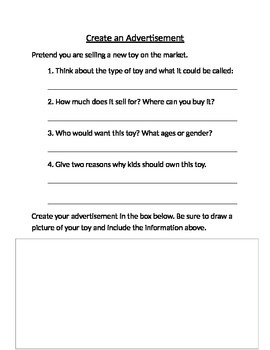
Persuasive Text - Create an Advertisement

Persuasive Text / Advertisement Comprehension "Summer School"

Persuasive Text Writing Centre: Advertisement - Grades 3-4

Persuasive Text / Advertisement Comprehension "We're Flying"

Persuasive Text / Advertisement Comprehension "Spring Kites"

Persuasive Text / Advertisement Comprehension "Make a Monster"
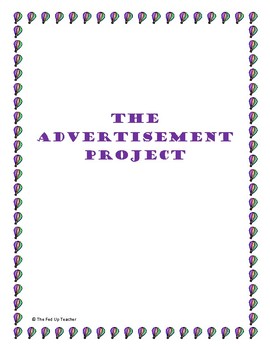
The Advertisement Project - Persuasive Text - The Art of Persuasion

Political Cartoon or Advertisement Analysis ( persuasive text )

Persuasive Writing Unit - Graphic Organizers, Activities, Rubric (Google Option)
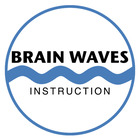
- Google Apps™

End of Year Persuasive Writing Unit - Designing a Roller Coaster & Writing an Ad

Persuasive Text -PowerPoint Lesson, Practice Handouts, and Assessment

Identifying the Advertisement parts

Persuasive Texts Reading Boom Cards™

- Internet Activities
- We're hiring
- Help & FAQ
- Privacy policy
- Student privacy
- Terms of service
- Tell us what you think

IMAGES
VIDEO
COMMENTS
Let your competitor's detractors be your best advocates. 7. Heinz: Ed Sheeran. Apparently, Ed Sheeran is Heinz Ketchup's biggest fan. This silly commercial is part of Heinz's ad campaign in the UK right now, where the company is attempting to get ketchup just as popular there as it is in the US.
Persuasive Advertising Techniques. 1. The Carrot and The Stick. Humans are hardwired to move towards pleasure, like a horse towards a carrot, and away from pain, like a donkey avoids a stick. When people read or watch your advertisements, "carrots", or promises of gain, can fill your prospects with hope and compel them to pursue that potential ...
It taps into emotions of power and self-worth to have products that other people do not have or didn't get the chance to purchase on time. 3. Writing in the Second Person. Using second-person language with pronouns like "you" and "yours" is another important technique to use in persuasive advertising.
Persuasive ads take finesse to craft, but there are core principles you can keep in mind as you write your own persuasive advertising: 1. Appeal emotionally. At the center of nearly all persuasive advertising is an emotional appeal. Think of ways your ads can create positive emotions in potential customers. Make people laugh.
This should dictate every creative decision you make while concepting, writing, preparing and physically making a commercial. Be simple, and tightly connect everything in your script to your core concept. Often, the most persuasive commercials are the simplest ones. Take a look at this classic advertisement by Pan Am.
Whereas persuasive advertising appeals to people's emotions, informative advertising appeals to their logical side. The latter tends to work well for complex products with lots of features, or a product that needs lots of explaining. The two styles can also be mixed to create something even more potent—a Ferrari F430 can accelerate from 0 ...
The Art of Rhetoric: Persuasive Techniques in Advertising: This online video describes how advertisers use pathos or emotion, logos or logic, and ethos or credibility/character in order to persuade consumers.. Persuasive Techniques in Advertising Video Transcription: A transcript of the video provided by Chelsea Majors
Ethos, pathos and logos are the three categories of persuasive advertising techniques. Each category invokes a different appeal between speaker and audience. Ethos calls upon the ethics, or what we'd call the values, of the speaker. Pathos elicits emotions in the audience. Finally, logos puts logic into play by using evidence and facts.
What Is Persuasive Advertising. Persuasive advertising is a form of marketing that seeks to convince or sway people to take a specific action, such as making a purchase, by presenting arguments and information in a way that appeals to the target audience's emotions, values, beliefs, or needs. This type of advertising often relies on techniques ...
A persuasive text can be an argument, exposition, discussion, review or even an advertisement. How is a persuasive text structured? A persuasive text is organised to include a 'statement of position', 'arguments' and a 'reinforcement of position statement' The statement of position gives an overview of the argument and reveals the ...
Sandwich delivery ads. Pizza delivery examples of persuasive copy for Google Ads. One relies on logical and ethos vs emotional appeal. Logical and ethos vs emotional appeal for pizza delivery Google Ads. Nike sneakers Google Ads: These are not Nike stores, so they lack the brand's built in credibility.
As with persuasive texts in general, advertisements can take many forms - from billboards and radio jingles to movie trailers and pop-ups on your computer. In this guide, we'll work towards writing a standard magazine-format advertisement known as the print ad. Print ads are text-heavy enough to provide something meaty for our students to ...
Persuasive Techniques in Advertising The persuasive strategies used by advertisers who want you to buy their product can be divided into three categories: pathos, logos, and ethos. Pathos: an appeal to emotion. An advertisement using pathos will attempt to evoke an emotional response in the consumer. Sometimes, it is a positive emotion such as ...
Understanding Persuasive Writing. Persuasive writing is an art that shapes our decisions, beliefs, and actions daily. Whether convincing a friend to try a new restaurant, supporting a political candidate, or buying a product, persuasive elements are ever-present. To master persuasive writing, it's crucial to comprehend the underlying ...
Persuasive Writing Examples in Advertising Campaigns. Ads are prime persuasive writing examples. You can flip open any magazine or watch TV for an hour or two to see sample after sample of persuasive language. Here are some of the most popular ad campaigns of all time, with links to articles explaining why they were so successful. Nike: Just Do It
1. I Want to Buy the World a Coke. In our opinion, one of the best persuasive commercials is Coca-Cola's "I Want to Buy the World a Coke". Aside from the New Seekers' catchy jingle, the ad is powerful because it focuses on the consumer rather than the product.
This video is a collection of 4 commercials used to help students understand elements of persuasive text. Parallel commercials for persuasive text examples ...
Make sure to grab the attention of your target market, in other words, who you are trying to attract. You must get them interested in your product, create a desire for them to buy it, and then get ...
A persuasive text is a form of non-fiction writing which aims to convince the reader of a certain point of view. The purpose is usually to encourage the reader to buy or do something. Adverts and newspaper columns are good persuasive writing examples. Though there are many techniques to write persuasively, most persuasive texts include a ...
Persuasive language is written to convince the reader to do or think something. Many pieces of writing use persuasive language, such as reviews, proposals, adverts, brochures and editorials. Key features of persuasive advertising include: Alliteration, rhyme and wordplay for catchy slogans. Appealing language such as 'free', 'exclusive' and ...
Advertisement: Lower primary Card 8- Grades 1 & 2 This Persuasive Text Writing Centre provides a Text Card with an engaging, levelled and illustrated advertisement text sample that is supported by three Activity Cards, six photocopiable worksheets and a Graphic Organiser. The three Activity cards are divided as follows: 1.
Key legal issues for companies to consider when advertising on social media or running a contest, sweepstakes, or other promotion through social media platforms, including guidance on preventing ...
The recovery of occluded human meshes presents challenges for current methods due to the difficulty in extracting effective image features under severe occlusion. In this paper, we introduce DPMesh, an innovative framework for occluded human mesh recovery that capitalizes on the profound diffusion prior about object structure and spatial relationships embedded in a pre-trained text-to-image ...